Honeywell LYNXR-2 User Manual
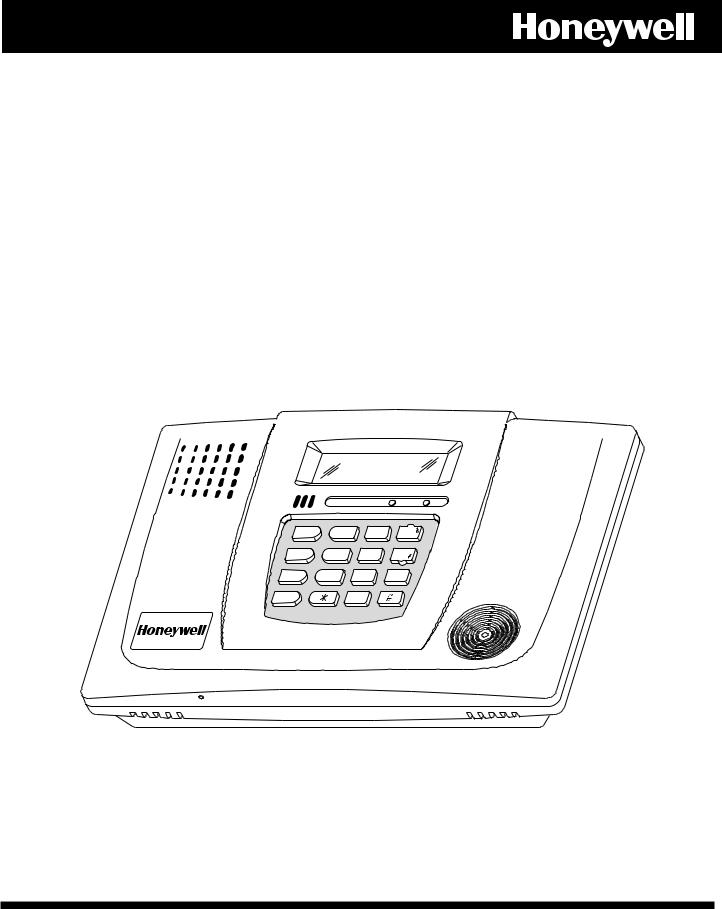
LYNXR-2 Series
Security Systems
Installation and Setup Guide
ARMED READY
OFF |
1 |
|
|
2 |
3 |
ESCAPE |
RECORD |
|
VOLUME |
PLAY |
|
AWAY |
4 |
|
|
5 |
6 |
ADD |
LIGHTS ON |
|
TEST |
BYPASS |
|
STAY |
7 |
|
8 |
|
9 |
DELETE |
LIGHTS OFF |
|
CODE |
|
CHIME |
AUX |
|
|
0 |
|
|
SELECT |
STATUS |
NO DELAY |
FUNCTION |
||
K15011 7/08 Rev. A

RECOMMENDATIONS FOR PROPER PROTECTION
The Following Recommendations for the Location of Fire and Burglary Detection Devices Help Provide Proper Coverage for the Protected Premises.
Recommendations for Smoke and Heat Detectors
With regard to the number and placement of smoke/heat detectors, we subscribe to the recommendations contained in the National Fire Protection Association's (NFPA) Standard #72 noted below.
• Early warning fire detection is best achieved by the installation of fire detection equipment in all rooms and areas of the household as follows: For minimum protection a smoke detector should be installed outside of each separate sleeping area, and on each additional floor of a multi-floor family living unit, including basements. The installation of smoke detectors in kitchens, attics (finished or unfinished), or in garages is not normally recommended.
• For additional protection the NFPA recommends that you install heat or smoke detectors in the living room, dining room, bedroom(s), kitchen, hallway(s), attic, furnace room, utility and storage rooms, basements and attached garages.
In addition, we recommend the following:
•Install a smoke detector inside every bedroom where a smoker sleeps.
•Install a smoke detector inside every bedroom where someone sleeps with the door partly or completely closed. Smoke could be blocked by the closed door. Also, an alarm in the hallway outside may not wake up the sleeper if the door is closed.
•Install a smoke detector inside bedrooms where electrical appliances (such as portable heaters, air conditioners or humidifiers) are used.
•Install a smoke detector at both ends of a hallway if the hallway is more than 40 feet (12 meters) long.
•Install smoke detectors in any room where an alarm control is located, or in any room where alarm control connections to an AC source or phone lines are made. If detectors are not so located, a fire within the room could prevent the control from reporting a fire or an intrusion.
THIS CONTROL COMPLIES WITH NFPA REQUIREMENTS FOR TEMPORAL PULSE
SOUNDING OF FIRE NOTIFICATION APPLIANCES.
KITCHEN |
|
|
KITCHEN |
DINING |
BEDROOM |
|
BEDROOM |
BEDROOM |
|||
DINING |
TV ROOM |
|
|
||
|
|
|
|
||
|
|
|
LIVING ROOM |
BEDROOM |
|
|
|
|
|
||
LIVING ROOM |
BEDROOM |
BEDROOM |
|
|
|
|
|
|
|
|
|
|
|
|
Smoke Detectors for Minimum Protection |
||
|
|
|
Smoke Detectors for Additional Protection |
||
BEDROOM |
|
|
Heat-Activated Detectors |
|
|
BEDROOM  BEDROOM
BEDROOM
LIVING |
|
|
KTCHN |
GARAGE |
|||
|
|
||||||
ROOM |
. |
||||||
CLOSED |
|||||||
|
|
TO |
|
|
DOOR |
||
|
|
|
|
|
|||
|
BEDROOM |
|
|||||
BASEMENT
01000-002-V0
Recommendations For Proper Intrusion Protection
•For proper intrusion coverage, sensors should be located at every possible point of entry to a home or premises. This would include any skylights that may be present, and the upper windows in a multi-level building.
•In addition, we recommend that radio backup be used in a security system. This will ensure that alarm signals can be sent to the alarm monitoring station in the event that the telephone lines are out of order (alarm signals are normally sent over the phone lines, if connected to an alarm monitoring station).
-2 -
Table of Contents |
|
SYSTEM FEATURES .................................................................................................................................. |
5 |
MOUNTING THE CONTROL..................................................................................................................... |
6 |
WIRING CONNECTIONS........................................................................................................................... |
7 |
CONNECTING/CONFIGURING COMMUNICATIONS DEVICES ........................................................ |
9 |
AC POWER AND BACKUP BATTERY.................................................................................................... |
12 |
INSTALLING WIRELESS ZONES........................................................................................................... |
14 |
MECHANICS OF PROGRAMMING ........................................................................................................ |
17 |
ZONE RESPONSE TYPE DEFINITIONS ............................................................................................... |
19 |
DATA FIELD DESCRIPTIONS ................................................................................................................ |
21 |
56 ENHANCED ZONE PROGRAMMING MODE ................................................................................ |
37 |
80 DEVICE PROGRAMMING MENU MODE ...................................................................................... |
41 |
81 ZONE LIST MENU MODE................................................................................................................ |
45 |
83 ENHANCED SEQUENTIAL MODE ................................................................................................ |
47 |
84 ASSIGN ZONE VOICE DESCRIPTORS .......................................................................................... |
50 |
85 RECORD CUSTOM VOICE DESCRIPTORS................................................................................... |
52 |
REMOTE PROGRAMMING/CONTROL (DOWNLOADING) ................................................................ |
53 |
SYSTEM OPERATION.............................................................................................................................. |
55 |
KEYPAD FUNCTION SUMMARY........................................................................................................... |
60 |
TESTING THE SYSTEM .......................................................................................................................... |
61 |
SYSTEM COMMUNICATION .................................................................................................................. |
62 |
TROUBLESHOOTING GUIDE ................................................................................................................ |
65 |
PROGRAMMING DEFAULT TABLES.................................................................................................... |
68 |
LYNXR-2 CONTROL DEFAULTS ..................................................................................................... |
68 |
LYNXR-2SIA CONTROL DEFAULTS............................................................................................... |
70 |
REGULATORY AGENCY STATEMENTS .............................................................................................. |
74 |
LIMITATIONS OF THIS SYSTEM STATEMENT.................................................................................. |
75 |
UL NOTICES.............................................................................................................................................. |
76 |
SIA QUICK REFERENCE GUDE ............................................................................................................ |
76 |
CONTACTING TECHNICAL SUPPORT................................................................................................. |
77 |
INDEX......................................................................................................................................................... |
83 |
SPECIFICATIONS..................................................................................................................................... |
86 |
SUMMARY OF CONNECTIONS DIAGRAM .......................................................................................... |
87 |
-3-
- 4 -
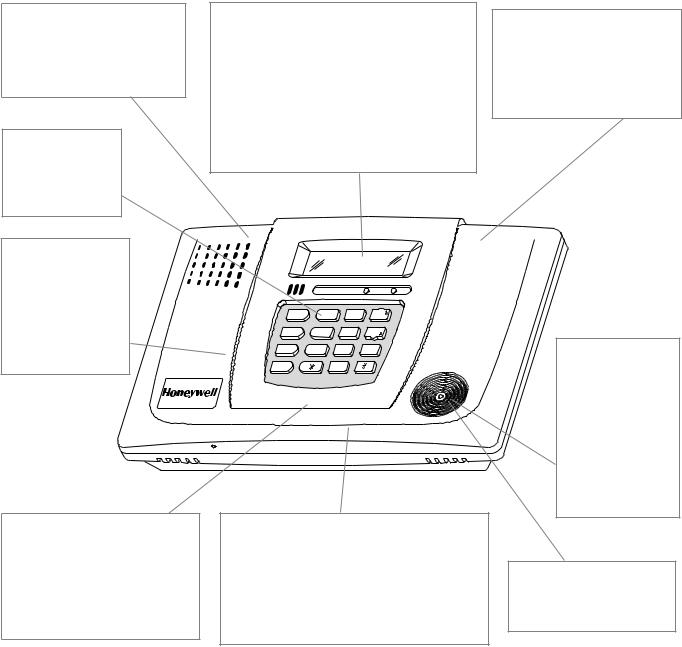
|
LYNXR-2 Series Installation and Setup Guide |
|
|
System Features |
|
|
|
|
UL |
LYNXR-2 Series is not intended for UL985 Household Fire applications unless a 24-hour backup battery |
|
(P/N LYNXRCHKIT-HC or LYNXRCHKIT-SHA) is installed. |
||
|
Powerline Carrier Devices have not been evaluated by UL. |
|
|
|
|
The LYNXR-2 Series control is a self-contained, rechargeable wireless control/communicator that features easy installation and usage. A built-in speaker provides voice annunciation of system status along with voice descriptors of each zone. An internal module (if provided) allows the LYNXR-2 Series to communicate with the Central Station via the Internet. The following illustration highlights the main features of this system.
ZONES and DEVICES
•Up to 24 wireless zones (5800 Series transmitters)
•Up to 16 wireless button zones
•Up to 8 powerline carrier devices
•Supports wireless keypads
8 USER CODES
•Installer code
•Master code
•5 Secondary codes
•Duress code
•3 Panic functions
COMMUNICATION
• Ademco Low Speed
• Sescoa/Radionics
• Ademco Express
•Ademco Contact ID
•Paging feature
•Internet central station communication
•GSM cellular central station communication
PROGRAMMING
•Options stored in EEROM
•Can be uploaded, downloaded or controlled via IBM-compatible computer using Compass downloader software and specified HAYES modem or via capable GSM or IP communications module
•Voice prompt programming mode
FEATURES
•Real-time clock display and Fixed-Word display
•Message center (for user recorded messages)
•Voice announcement of system and zone status
•Voice chime
•Alarm clock
•Reminder
•X10 scheduling
•Latch key reports
•Automatic stay arming
•Remote phone control
•“Follow me” reminder and system Announcements
SYSTEM POWER
•Primary Power: Ademco K10145X10 plug-in transformer, 110VAC to 9VAC, 25VA output (K10145CN in Canada)
•Backup battery: Rechargeable nickel-metal hydride battery pack rated at 7.7Vdc.
ARMED READY
OFF |
1 |
|
|
2 |
3 |
ESCAPE |
RECORD |
|
VOLUME |
PLAY |
|
AWAY |
4 |
|
|
5 |
6 |
ADD |
LIGHTS ON |
|
TEST |
BYPASS |
|
STAY |
7 |
|
8 |
|
9 |
DELETE |
LIGHTS OFF |
|
CODE |
|
CHIME |
AUX |
|
|
0 |
|
|
SELECT |
STATUS |
NO DELAY |
FUNCTION |
||
OTHER FEATURES
•Exit error feature (detects difference between an actual alarm and exit alarm caused by leaving a door open after the exit delay expires)
•Event log stores up to 84 events
•Macro/ 1-button paging
•RF jam detection
•Remote phone control
•Compatible with encrypted (high-security) devices
ALARM OUTPUT
•Built-in sounder
•Piezo output (30mA max.)
•Bell output (120mA max.)
•Steady output for burglary/panic
•Temporal pulse output for fire alarms
•Long range radio/audio alarm verification
SPECIAL FEATURES
•Two-way voice communication
•Speaker phone operation
•Supports AlarmNet remote services
- 5 -
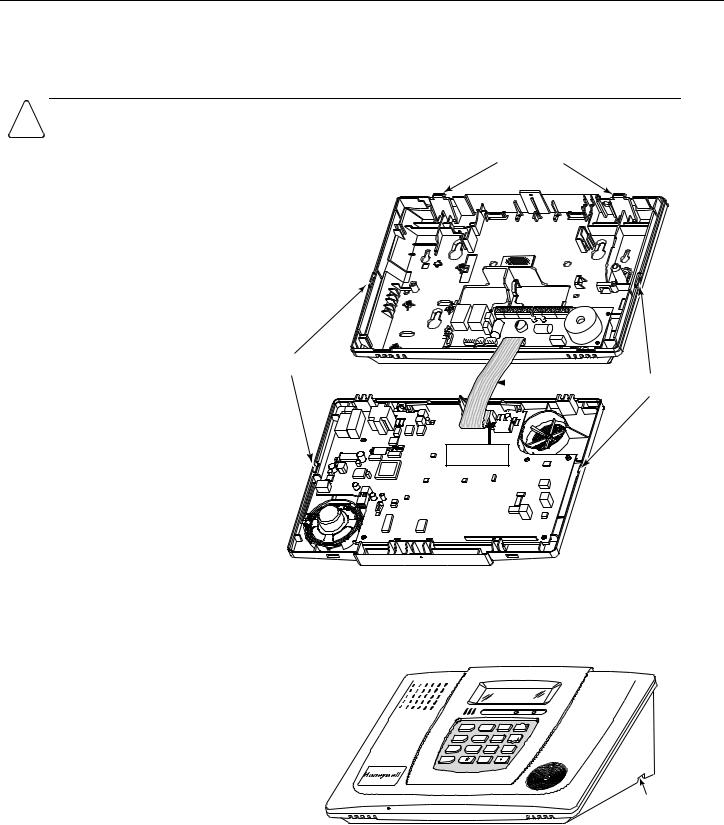
LYNXR-2 Series Installation and Setup Guide
Mounting the Control
Wall Mounting
The illustration below shows the front assembly separated from the back plate.
! |
DO NOT disconnect the ribbon cable from the terminal strip board. Disconnect the cable only from the |
front assembly board. |
1.Release the front assembly from the back plate by depressing the two locking tabs at the top of the unit with the blade of a medium size screwdriver.
2.Once these tabs have been released, insert the screwdriver in the side of the case and release the side locking tabs by gently twisting.
3.Carefully disconnect the ribbon cable from the front assembly, leaving the ribbon cable connected to the terminal block PC board. The back plate contains the terminal block for making wiring connections.
4.Mount the back plate to a sturdy wall, feeding the field wiring through the appropriate openings in the back plate.
5.After wiring connections are made, carefully reconnect the ribbon cable to the front assembly PC board connector (properly aligning the red wire).
6.Snap the front assembly to the back plate so it is secured by the locking tabs.
LOCKING
TABS
LOCKING TABS
|
|
|
|
|
|
|
|
|
|
RED WIRE |
LOCKING |
|
|
|
|
|
|
|
|
|
|
|
MARKING |
TABS |
|
|
|
|
|
|
|
|
|
|
|
|
|
|
|
|
|
|
|
|
|
|
|
|
|
|
|
|
|
|
|
|
|
|
|
|
|
|
|
|
|
|
|
|
|
|
|
|
|
|
|
|
|
|
|
|
|
|
|
|
|
|
|
|
|
|
DISCONNECT
THIS END ONLY!
09012-002-V0
Desktop Mounting
For desktop use the optional mounting base (model LYNX-DM, purchased separately) must be used.
1.Slide the control panel onto the mounting base locking tabs.
2.Bring all wiring through the bottom of the mounting base, using one of the three wire entry locations, before making connections to the control panel.
3.Use tie-wraps to secure the wiring to the built-in wire loops as needed. Use the two supplied screws to secure the control panel to the mounting base.
ARMED READY
|
OFF |
|
1 |
2 |
3 |
|
ESCAPE |
|
RECORD |
VOLUME |
PLAY |
|
AWAY |
|
4 |
5 |
6 |
|
ADD |
LIGHTS ON |
TEST |
BYPASS |
|
STAY |
7 |
8 |
|
9 |
|
DELETE |
LIGHTS OFF |
CODE |
CHIME |
||
AUX |
|
|
0 |
|
|
SELECT |
STATUS |
|
NO DELAY |
FUNCTION |
|
WIRE ENTRY KNOCKOUT (1 of 3)
09015-002-V0
- 6 -
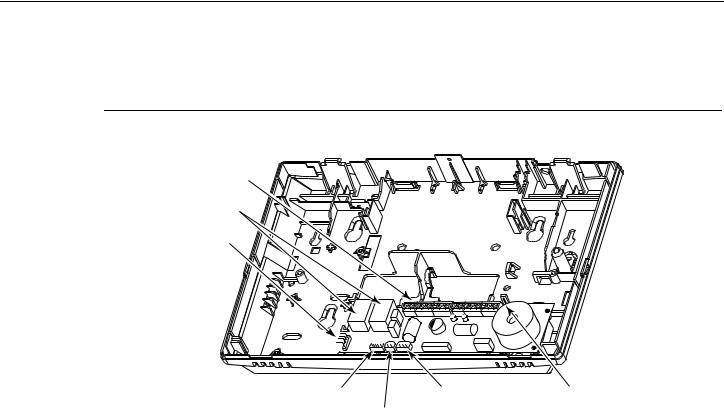
LYNXR-2 Series Installation and Setup Guide
Wiring Connections
Wiring Overview
The following summarizes the connections required. Refer to the Wiring Connections paragraph and the Summary of Connections diagram on the inside back cover when making connections.
UL |
External sounders have not been evaluated by UL. |
|
|
TERMINAL
STRIP
TELEPHONE
CONNECTIONS
LRR/IP
COMMUNICATIONS
PORT
GSML/GSMVL |
|
SUPER HIGH-CAPACITY |
LOCAL |
COMMUNICATIONS |
|
BATTERY CONNECTOR |
SOUNDER |
PORT |
|
|
DISABLE |
STANDARD |
|
||
HIGH-CAPACITY |
|
||
BATTERY CONNECTOR |
09012-009-V0 |
||
Wiring Connections
1.Make Earth Ground Connection - The designated earth ground terminal (1) must be terminated in a good earth ground for the lightning transient protective devices in this product to be effective. The following are examples of good earth grounds available at most installations:
Metal Cold Water Pipe - Secure a non-corrosive metal strap (copper is recommended) to the pipe that is electrically connected and secured to which the ground lead is electrically connected and secured.
AC Power Outlet Ground - Available from 3-prong, 120VAC power outlets only. To test the integrity of the ground terminal, use a three-wire circuit tester with neon lamp indicators, such as the UL Listed Ideal Model 61–035, or equivalent, available at most electrical supply stores.
a.Connect terminal 1 to a good earth ground.
2.Make Phone Line Connections - For local or full line seizure follow the appropriate steps below.
Local Seizure
a.Connect the incoming phone line to either the 8-position jack or terminals 2 (TIP) and 3 (RING) on the Lynx.
b.Connect the handset phone lines to either the RJ11 jack or terminals 4 (TIP) and 5 (RING).
Full Line Seizure: The control must be placed in series with the incoming phone line. Plugging the Direct Connect Cord directly into the RJ31X jack, allows the control to seize the phone line when an alarm occurs and normal phone line usage by the premises phones if the plug needs to be removed.
c.Cut the incoming RING and TIP phone lines (typically red and green, respectively) and connect them to RJ31X terminals 4 (red) and 5 (green).
d.Connect the premises end of the cut RING and TIP wires to RJ31X terminals 1 (grey) and 8 (brown) respectively.
e.Wire the flying leads of a Direct Connect Cord to the control’s phone terminals as shown in the diagram or plug into the 8-position jack.
f.Plug the Direct Connect Cord into the RJ31X jack.
- 7 -
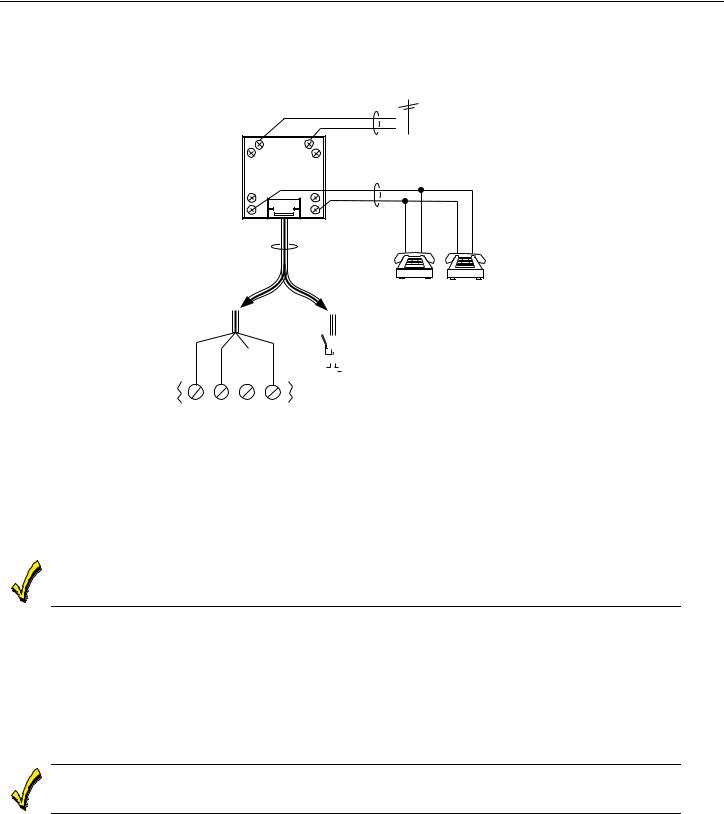
LYNXR-2 Series Installation and Setup Guide
Wiring Connections
|
|
|
|
INCOMING |
|
|
|
|
PHONE LINE |
|
|
|
|
RING |
|
|
|
|
TIP |
RED |
4 |
5 |
|
GREEN |
|
3 |
|
6 |
TO |
|
|
|
|
|
|
RJ31X |
|
PREMISES PHONES |
|
|
|
|
|
RING |
|
2 |
|
7 |
TIP |
GREY |
1 |
|
8 |
BROWN |
|
|
DIRECT |
||
|
|
CONNECT |
||
|
|
CORD |
|
|
OR
|
|
GREEN |
RED |
|
BROWN |
GREY |
|
|
|
|
|
|
|
|
|
|
|
|
|
|
|
|
|
||||
|
|
|
|
|
|
|
|
|
|
||||
|
|
|
|
|
|
|
|
|
|
|
|
|
|
|
|
|
|
|
|
|
|
|
|
|
|
|
|
|
|
|
|
|
|
|
8-POSITION |
||||||
|
|
TIP |
RING |
TIP |
RING |
|
JACK |
||||||
|
} } |
|
|
|
|
|
|
|
|||||
|
|
INCOMING |
|
|
TO |
|
|
|
|
|
|
|
|
|
|
PHONE LINE |
PREMISES |
|
|
|
|
|
|
|
|||
|
|
|
|
PHONES |
|
|
|
|
|
|
|
||
|
|
|
|
|
|
|
|
|
|
|
|
|
01000-008-V0 |
|
|
|
|
Full Line Seizure Connections |
|||||||||
|
|
||||||||||||
UL |
Do not remove the local sounder shorting jumper (shunt). |
||||||||||||
|
External sounders and powerline carrier devices have not been evaluated by UL |
||||||||||||
|
|
|
|
|
|
|
|
|
|
|
|
|
|
LOCAL SOUNDER DISABLE: The Master Keypad’s built-in piezo sounder can be disabled by removing the shorting jumper (shunt) on the terminal board. If disabled, however, no sounding will occur upon AC loss, since the external sounder does not operate when AC power is lost.
3.Make External Sounder Connections - The control panel supports either a 6-14VDC piezo sounder (30mA max.) or 6-14VDC bell (120mA max.; e.g. ADEMCO WAVE2EX).
a.Connect a piezo sounder to terminals 10 (+) and 11 (–); OR a bell to terminals 11 (–) and 12 (+).
4.Disable Local Sounder Option - If required the Master Keypad’s built-in piezo sounder can be disabled.
a.Remove the shorting jumper (shunt) on the terminal board.
5.Make Powerline Carrier Device Connections - The control panel supports up to 8 Powerline Carrier Devices. If using these devices, they must be connected to the K10145X10 transformer, as shown in the SUMMARY OF CONNECTIONS diagram.
a.Connect the com/data/sync/ lines from the transformer to terminals 9, 13, and 14, respectively.
If not using the supplied connection cable, you may need to reverse the black and yellow wire connections. Refer to the 80 Device Programming Menu Mode section for details on programming Powerline Carrier Devices.
- 8 -
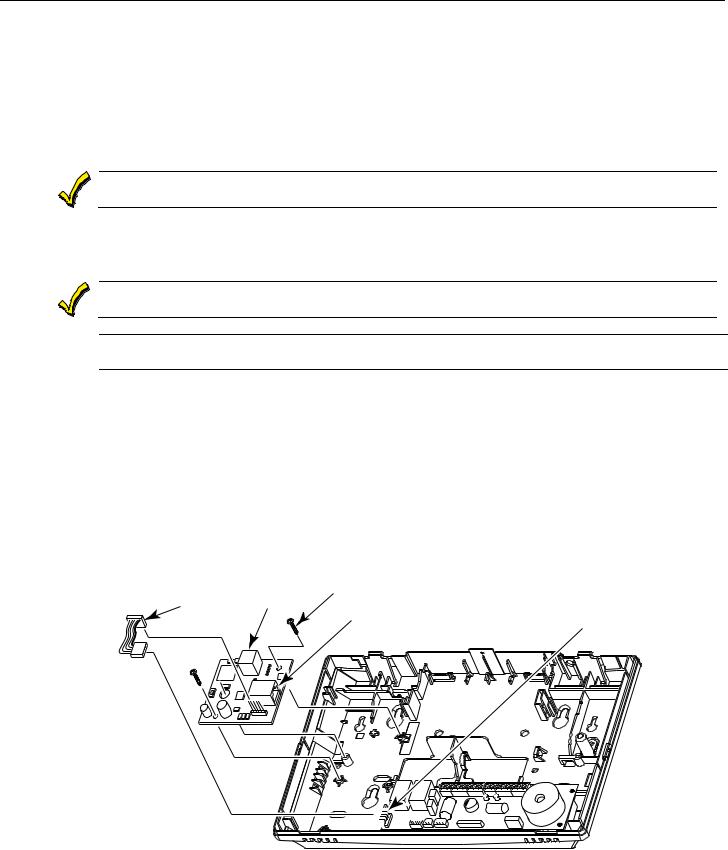
LYNXR-2 Series Installation and Setup Guide
Connecting/Configuring Communication Modules
General
This LYNXR-2 Series supports central station reporting via the internet using wireless (GSM) and hardwire (IP) communications modules. It also supports upload/download programming capability via the Internet or a Private local area network (Intranet). This allows site maintenance independent of central station monitoring, and modification to sites globally via the Internet or through a private LAN. Refer to the instructions provided with the LRR/IP Communications Device being installed for additional information regarding its installation, programming, and registration.
LYNXR-2 Series does not support the 7845i-ENT remote access feature.
Connecting Long Range Radio and Internet Communication Devices
Connect and configure the communications device as follows (refer to the Installation Instructions for device that you are installing for additional information):
The wire run between the LYNXR-2 Series and the Communications Device must not exceed ten (10) feet.
UL |
The 7845i-ENT has been evaluated by UL for Household Burglary installations but has not been evaluated |
for Household Fire installations. |
AlarmNet 7847i-L* Communications Device
1.Install the module into the LYNXR-2 Series back plate and secure it with the two provided screws. Refer to the diagrams that follow.
2.Connect the provided ribbon cable between the module and the PC board. This cable provides DC power and ground for the module and data in/data out connections.
3.Connect the device to the Internet via a cable/DSL modem and router or to an Intranet (LAN) via the appropriate Ethernet connection.
* When available. The 7847i-L module has not been evaluated by UL.
7720P |
SCREW (2) |
|
PROGRAMER |
|
|
CONNECTION |
|
LRR / IP |
CABLE |
RJ45 |
|
|
COMMUNICATION |
|
|
(FOR INTERNET CONNECTION) |
PORT |
09012-008-V1
Installing the 7847i-L Communications Module
- 9 -
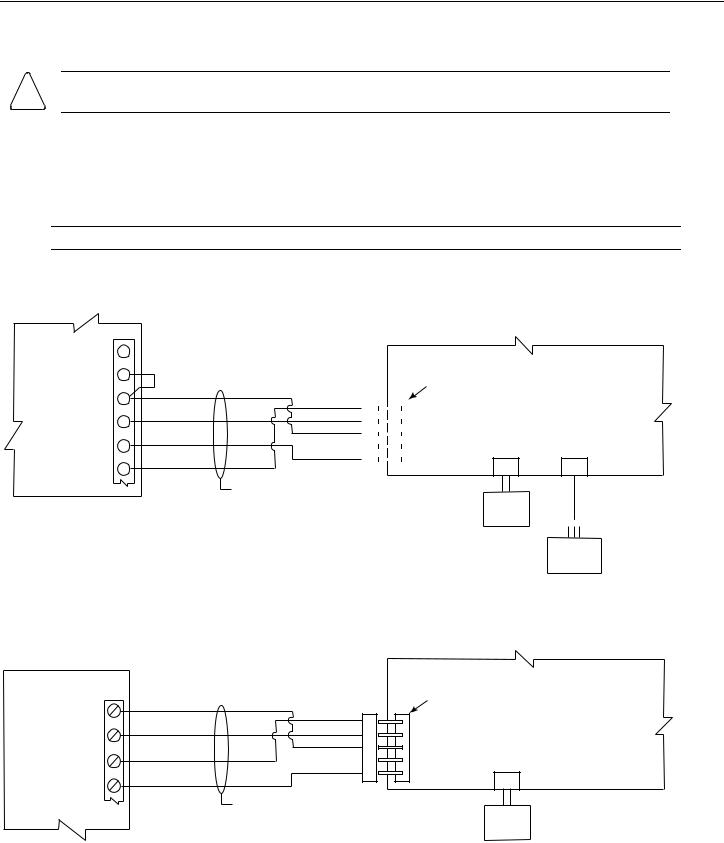
LYNXR-2 Series Installation and Setup Guide
Connecting/Configuring Communication Modules
AlarmNet 7845GSM, 7845i-GSM*, 7845i-ENT, 7845i or 7847i-E* Communications Device
!The 7845i-ENT and 7845i cannot be used for installations requiring 24-hour standby.
1.Connect the 4-wire communications cable to the LRR/IP Communications port on the LYNXR-2 Series.
2.Connect the four wires to the specific Communications device as shown in the accompanying figures.
3.If you are installing a 7845GSM or 7845i-GSM you must also install a jumper between terminals 2 and 3 on the communications device.
4.Connect the device to the Internet via a cable/DSL modem and router or to an Intranet (LAN) via the appropriate Ethernet connection, if applicable.
UL AlarmNet 7845GSM and 7845i-GSM modules have not been evaluated by UL. * When available
7845GSM / |
TB1 |
|
|
|
|
|
|
|
|
|
|
|
7845i-GSM |
|
|
|
|
|
|
|
|
|
|
|
|
|
1 |
|
|
|
CONTROL PANEL |
|
|
|
|
|||
|
2 |
|
|
|
|
|
|
|
|
|
|
|
|
|
RED |
|
|
|
|
|
LRR/IP COMMUNICATIONS PORT |
|
|
|
|
ECP (+) VOLTAGE INPUT |
34 |
|
|
|
|
|
|
|
|
|
|
|
|
GRN |
|
|
|
|
DATA IN |
|
|
|
|
||
GND |
4 |
BLK |
BLK |
|
|
|
|
GND |
|
|
|
|
|
RED |
|
|
|
|
|
|
|
|
|||
|
|
|
|
|
|
|
+12 VDC |
|
|
|
|
|
Z1/Z2 OR DATA IN |
5 |
YEL |
|
|
|
|
|
|
|
|
|
|
|
|
|
|
|
NC |
|
|
|
|
|||
|
YEL |
|
|
|
|
|
|
|
|
|||
|
|
|
|
|
|
|
|
|
||||
|
|
|
|
|
|
|
DATA OUT |
|
|
|
|
|
Z3 OR DATA OUT |
6 |
GRN |
|
|
|
|
|
|
|
|
|
|
|
|
|
|
|
|
|
|
|
|
|||
|
4-WIRE CABLE (N4632-4) |
|
|
|
|
|
|
|
|
|
||
|
|
|
|
|
|
|
|
|
|
|
|
|
|
|
|
|
|
|
|
|
LYNX |
|
|
|
|
|
|
|
|
|
|
|
|
STANDARD |
|
|
|
|
|
|
|
|
|
|
|
|
CAPACITY |
|
|
|
|
|
|
|
|
|
|
|
|
BATTERY |
|
|
|
|
|
|
|
|
|
|
|
|
(OPTIONAL) |
|
LYNX |
|
|
|
|
|
|
|
|
|
|
SUPER |
HIGH |
|||
|
|
|
|
|
|
|
|
REQUIRED FOR |
CAPACITY |
|||
|
|
|
|
|
|
|
|
24-HR BACKUP |
BATTERY |
|||
Connecting AlarmNet 7845GSM / 7845i-GSM
CONTROL PANEL
7845i-ENT / 7845i
TB 1
LRR/IP COMMUNICATIONS PORT
(+) VOLTAGE INPUT |
RED |
|
|
|
GRN |
|
|
|
|
DATA IN |
|
|
BLK |
|
|
GND |
BLK |
GND |
|
|
RED |
||
|
|
+12 VDC |
|
|
|
|
|
DATA OUT |
GRN |
|
NC |
|
YEL |
||
|
|
DATA OUT |
|
|
YEL |
|
|
DATA IN |
|
|
|
|
|
|
|
|
|
4-WIRE CABLE (N4632-4) |
|
LYNX
STANDARD
CAPACITY
BATTERY
Connecting AlarmNet 7845i-ENT/7845i/7847i-E*
09012-018-V0
09012-019-V0
- 10 -
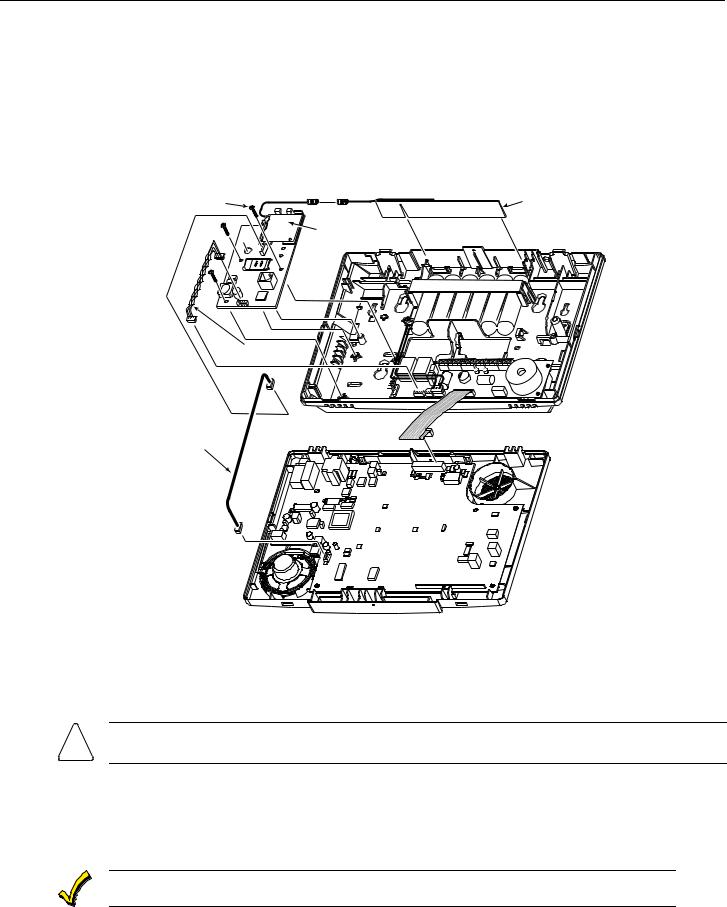
LYNXR-2 Series Installation and Setup Guide
Connecting/Configuring Communication Modules
AlarmNet GSML/GSMVL Communications Device
1.Install the module into the control back plate and secure it with the three provided screws.
2.Connect the antenna to the GSML/GSMVL module.
3.Insert the antenna into the retaining slots in the control back plate.
4.Use double-stick tape to secure antenna to the control back plate.
5.Connect the provided communications cable between the GSML/GSMVL module and the control’s PC board. This cable provides DC power and ground for the module and data in/data out connections.
6.If using the GSMVL, connect the provided shielded audio cable between the GSMVL module and the control’s PC board.
SCREW (3) |
ANTENNA |
|
|
|
GSML/GSMVL |
COMMUNICATIONS
CABLE
AUDIO CABLE (GSMVL ONLY)
09012-017-V1
Installing the GSML/GSMVL Communications Module
LRR/IP Communications Device 24-Hour Standby Power
If you are installing the AlarmNet 7845GSM/7845i-GSM or 7847i-L, and require 24-hour standby, you must install the Super High Capacity battery P/N WALYNX-RCHB-SHA in the control.
!The 7845i-ENT and 7845i can not be used for installations requiring 24-hour standby.
Configuring Long Range Radio and Internet Communication Devices
1.Enable the communications device in programming field *55 and configure alarm reporting and module supervision in programming field *77.
2.Program the device as required using the 7720P programmer (refer to the Installation Instruction for the device that you are installing for additional information). Note that the device address must be set to 3.
The device must be registered before downloading or alarm reporting can take place.
- 11 -

LYNXR-2 Series Installation and Setup Guide
AC Power and Backup Battery
The system is powered by a 9VAC, 25VA Plug-in Transformer, ADEMCO K10145X10 (K10145CN in Canada). Refer to the wiring table below for wire gauge and length.
|
Distance from Transformer to Control |
Wire Gauge |
|
|
|
|
|
|
|
|
|
|
Up to 75 feet |
#20 |
|
|
|
|
|
|
75 to 150 feet |
#18 |
|
|
|
|
|
|
150 to 300 feet |
#16 |
|
|
|
|
|
|
|
|
|
Use only the provided ADEMCO K10145X10 or K10145CN Transformer. Wiring to the AC Transformer must not exceed 300 feet using 16-gauge wire. The voltage reading between terminals 15 and 16 of the control must not fall below 9.00VAC.
Do not plug the transformer into the AC outlet until after all wiring connections have been made.
Backup battery
In the event of an AC power loss, the system is supported by a long life backup battery that is supervised for connection and for low voltage conditions. If the battery is missing, or a low battery condition is detected, a “low battery” message is displayed and a report is sent to the central station. In addition, the system will beep once every 45 seconds to audibly indicate a low battery condition (press any key to stop the beeping).
AC Power and Rechargeable Backup Battery
Connecting AC Power and backup battery
1.Connect wires from the K10145X10 (K10145CN) in Canada) AC Transformer to terminals 15 and 16 as shown in the wiring diagram.
2.Remove battery retainer.
3.Peel the backing from tape on the back plate.
4.Insert battery pack into back plate.
5.Install battery retainer.
6.Connect battery connector to receptacle on terminal block PC board.
7.After all wiring connections have been made, snap the front assembly to the back plate and plug the transformer into a 24-hour, 110VAC unswitched outlet.
Note: Rechargeable batteries may take up to 48-hours to fully charge. The “LOW BAT” message should clear within four hours or by entering Test Mode.
RETAINER
BATTERY
PACK 
TAPE
NOTE
LYNXRCHKIT-HC
BATTERY PACK SHOWN
BATTERY |
WIRING |
|
RECEPTACLE |
TERMINALS |
09012-003-V0 |
Ensure the cover is snapped closed prior to applying AC power.
- 12 -
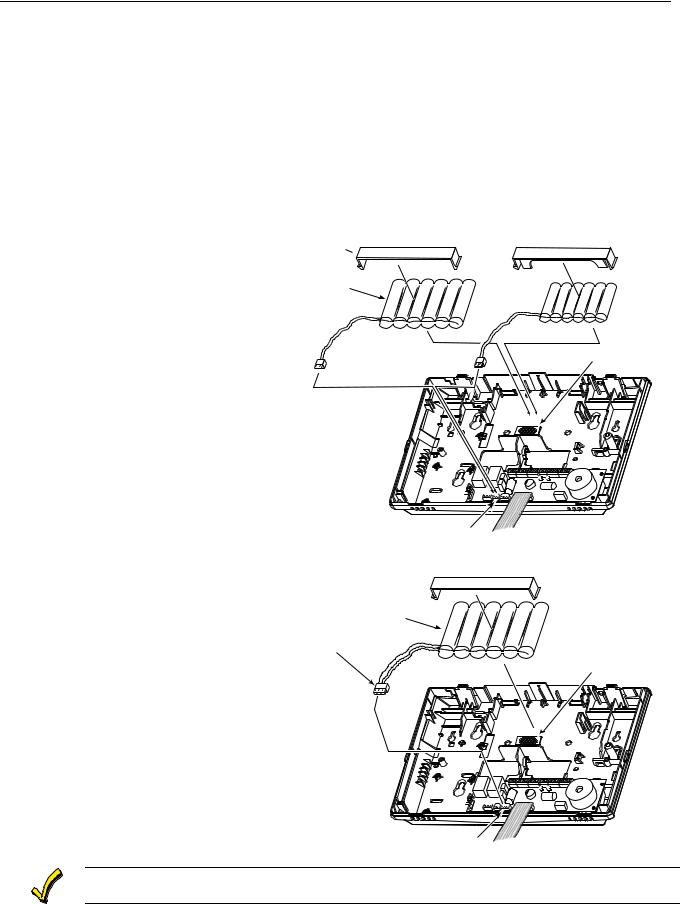
LYNXR-2 Series Installation and Setup Guide
AC Power and Backup Battery
AC Power and Rechargeable Backup Battery
The LYNXR-2 Series is equipped with an integral, replaceable, rechargeable battery pack rated at 7.7Vdc. Select the appropriate battery pack, based on the installation’s requirement, and install the battery pack.
Model/Part Number |
Battery StandbyTime |
Low Battery Notification |
LYNXRCHKIT-SC |
4-hours (minimum) |
Approximately 1-hour before battery depletion |
|
|
|
LYNXRCHKIT-HC |
24-hours (minimum) |
At least 1-hour before battery depletion |
|
|
|
LYNXRCHKIT-SHA |
24-hours (minimum) |
At least 1-hour before battery depletion |
|
|
|
Replacing the Rechargeable Battery
1.When battery replacement is required, unplug the transformer from the wall outlet, and open the control panel cover.
2.Remove the battery retainer and disconnect the battery pack connector from the receptacle on the terminal block PC board.
3.Remove the battery pack from the back plate.
4.If required, replace the tape that secures the battery pack.
5.Install a replacement battery pack (P/N LYNXRCHKIT-SC, LYNXRCHKIT-HC or LYNXRCHKIT-SHA) into the back plate.
6.Install the battery retainer.
7.Connect the battery connector to the receptacle on the terminal block PC board.
8.After the wiring connection has been made, snap the front assembly to the back plate.
9.Plug the transformer into a 24-hour, 110VAC unswitched outlet.
10.Rechargeable batteries may take up to 48hours to fully charge. The “LOW BAT” message should clear within four hours or by entering Test Mode.
LYNXRCHKIT-HC |
OR |
LYNXRCHKIT-SC |
RETAINER 
BATTERY
PACK
TAPE

 BATTERY CONNECTOR
BATTERY CONNECTOR
BATTERY
RECEPTACLE
LYNXRCHKIT-SHA
RETAINER
BATTERY
PACK
BATTERY
CONNECTOR
TAPE
BATTERY
RECEPTACLE |
09012-004-V1 |
Ensure the control panel assembly is snapped closed prior to applying AC power.
- 13 -

LYNXR-2 Series Installation and Setup Guide
Installing Wireless Zones
General Information
Zones: The control supports up to 24 wireless zones using 5800 Series transmitters, and up to 16 wireless buttons.
Range: The built-in RF receiver can detect signals from wireless transmitters within a nominal range of 200 feet.
Transmitters: 5800 Series transmitters have built-in serial numbers that must be entered into the system using the 56 or 83 interactive mode, or input to the control via the downloader. 5800 Series transmitters (except the 5800RL, which is described separately) do not have DIP switches. Each transmitter's zone number is programmed into the system in 56 mode. Some transmitters, such as the 5816 and 5817, can support more than one "zone" (referred to as loops or inputs). On the 5816, for example, the wire connection terminal block is loop 1; the reed contact is loop 2. Each loop must be assigned a different zone number.
|
The 5816 and 5817 Transmitters do not have EOL supervision of their loop wiring and the loop wiring must |
UL |
not exceed 3 feet. |
|
The 5800RL, 5802MN, 5802MN2, 5804, 5804BD, 5804BDV, 5804E, 5814, 5816TEMP, 5819, 5819S(WHS & |
|
BRS), 5828/5828V and 5850(GBD) transmitters have not been evaluated by UL. |
|
|
For button transmitters (RF "keys") such as the 5804 and 5801, you must assign a unique zone number to each individual button used on the transmitter. Each button on the transmitter also has a pre-designated loop or input number, which is automatically displayed.
House Identification
If you are using a 5804BD/5804BDV Wireless Keypad with the system, you must program a House ID Code (01–31) in field 24 to establish proper communication, and the keypad must be set to the same ID. House ID 00 disables all wireless keypads. An RF House ID is not necessary for other 5800 Series transmitters; the entry should be left at “00” (default) in those cases.
Transmitter Supervision
Except for some transmitters/keypads that may be carried off-premises (5804, 5804BD, 5804BDV, and 5804E), each transmitter is supervised by a check-in signal that is sent to the receiver at 70–90 minute intervals. If at least one check-in is not received from each supervised transmitter within a 12-hour period, the "missing" transmitter number(s) and "FAULT" will be displayed. The supervision for a particular transmitter in the system that may also be carried off the premises (5801, 5802MN) may be turned off by entering it as a "UR" (unsupervised RF) type, as described in the 56 Enhanced Zone Programming Mode section. 5800 Series transmitters have built-in tamper protection and will annunciate as a fault condition if covers are removed.
Transmitter Input Types
Each of the following transmitters has one or more unique factory-assigned input (loop) ID codes. Each of the inputs requires a programming zone (e.g., a 5804's four inputs require four button zones). Transmitters can be entered as one of the following types (see transmitter’s instructions for appropriate input type):
Type |
Description |
"RF" (Supervised RF) |
Sends periodic check-in signals, as well as fault, restore, and low battery signals. |
|
The transmitter must remain within the receiver's range. |
"UR" (Unsupervised RF) |
Sends all the signals that the "RF" type does, but the control does not supervise the |
|
check-in signals. The transmitter may therefore be carried off-premises. |
"BR" (Unsupervised Button RF) |
These only send fault signals. They do not send low battery signals until they are |
|
activated. The transmitter may be carried off-premises. |
|
|
Transmitter Battery Life
• Batteries in the wireless transmitters may last from 4–7 years, depending on the environment, usage, and the specific wireless device being used. Factors such as humidity, high or low temperatures, as well as large swings in temperature may all reduce the actual battery life in a given installation. The wireless system can identify a true low battery situation, thus allowing the dealer or user of the system time to arrange a change of battery and maintain protection for that point within the system.
- 14 -
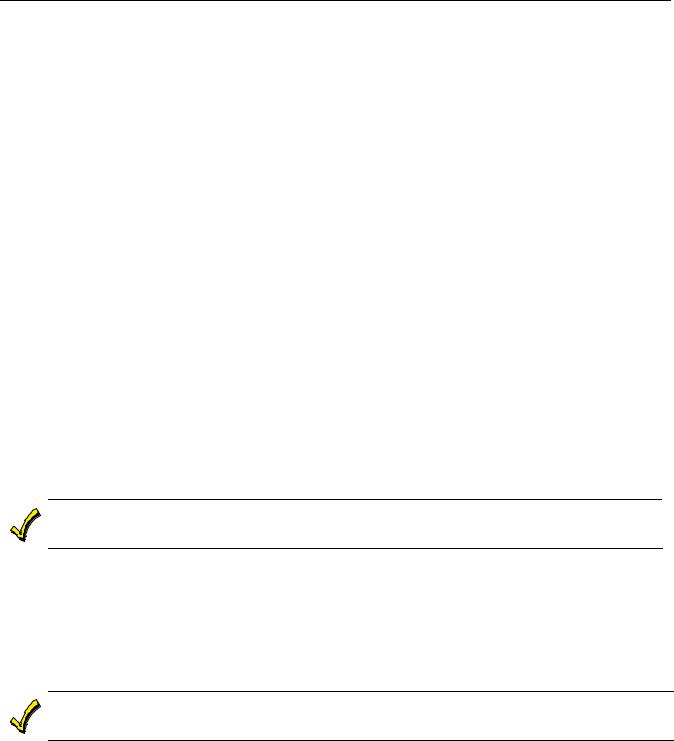
LYNXR-2 Series Installation and Setup Guide
Installing Wireless Zones
• Button-type transmitters should be periodically tested for battery life. The 5801, 5802MN, 5802MN2, 5804, 5804BD, 5804BDV, and 5804E button transmitters have replaceable batteries.
Using the Transmitter Sniffer Mode
Use this mode after all transmitters have been entered to check that all transmitters have been properly programmed.
1.Enter Installer code (4112) + [#] + 3.
Note: If the communicator is in the process of sending a report to the central station, the system will not go into the Sniffer mode. If so, wait a few minutes and try again.
2.The keypad will display all zone numbers, which have a non-zero Zone Type (even if serial numbers were not learned yet). Fault each transmitter in turn, causing each one to send a signal. As the system receives a signal from each of the transmitters, the zone number of that transmitter will disappear from the display. The transmitters may be checked upon installation, or in an installed system.
3.When all transmitters have been checked, exit Sniffer mode. Enter Installer Code (4112) + OFF.
Notes: (1) Sniffer mode does not automatically expire. You must manually exit (Installer Code + OFF) Sniffer mode to return to normal operation.
(2)All BR-type units must physically be activated to clear the display, since they do not automatically send check-in signals.
(3)When one button of a transmitter (RF, UR, or BR) is activated, all zones assigned to other buttons on that transmitter are cleared. This also applies to 5816 and 5817 transmitters that have multiple loops (zones).
(4)Any transmitter that is not “entered” will not turn off its zone number.
(5)For SIA installations, the following devices may be used as specified for panic (24-hour) alarm response:
•wireless keys which have two-button panic pairs available (e.g., 5804BDV), on which only the two-button panic pairs may be programmed for any 24-hour alarm response
•wireless keypads (e.g., 5828/5828V) keypads that have a two-second delay on the special function keys, or two-button panic pairs
•built-in keypad’s two-button panic pairs
Go/No Go Test Mode
5804E encrypted (High-Security) devices must be activated while the system is in Go/No Go Test Mode. Refer to the transmitter’s installation instructions for complete details. The system will confirm enrollment of the encrypted device by beeping two times.
The Go/No Go tests will verify adequate RF signal strength from the proposed transmitter location, and allow you to reorient or relocate transmitters if necessary, before mounting the transmitters permanently. This mode is similar to the transmitter Test mode, except that the wireless receiver gain is reduced. This will enable you to make sure that the RF signal from each transmitter is received with sufficient signal amplitude when the system is in the normal operating mode.
1.Enter Installer Code (4112) + [#] + 8.
2.Once you have placed transmitters in their desired locations and the approximate length of wire to be run to sensors is connected to the transmitter's screw terminals (if used), fault each transmitter.
Conducting this test with your hand wrapped around the transmitter will cause inaccurate results.
On button type transmitters that have been programmed to set ARM AWAY, ARM STAY, or DISARM, pressing a button will take the system out of the Go/No Go Test mode causing the programmed action to occur.
Note: On button type transmitters that have been programmed to set ARM AWAY, ARM STAY, or DISARM, pressing a button will take the system out of the Go/No Go Test mode and cause the programmed action to occur.
a.The keypad will beep three times indicating signal reception and will display the appropriate zone number.
b.If the keypad does not beep, reorient or move the transmitter to another location. Usually a few inches in either direction is all that is required.
3.If each transmitter produces the proper keypad response when it is faulted, you can then permanently mount each of the transmitters according to the instructions provided with them.
4.Exit the Go/No Go Test mode by entering: Installer Code (4112) + OFF.
-15 -
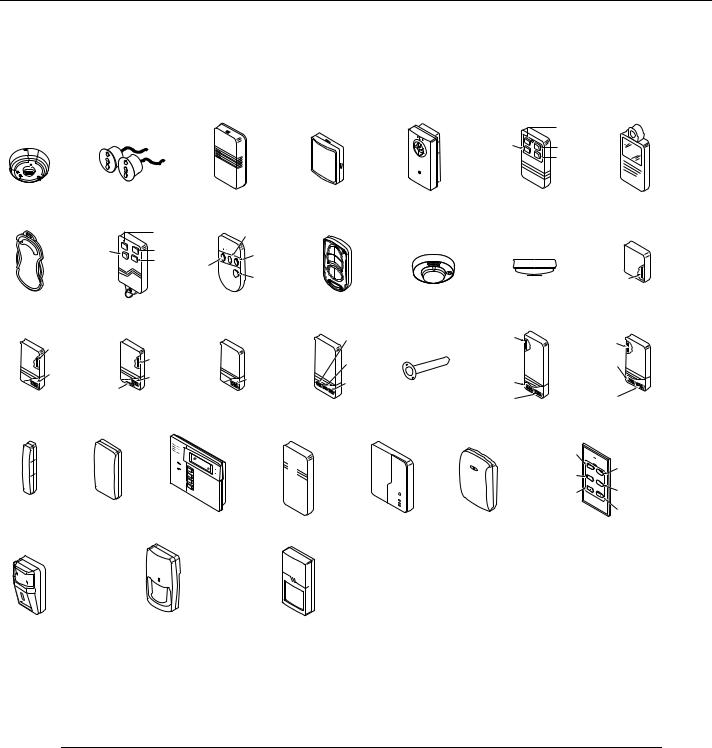
LYNXR-2 Series Installation and Setup Guide
Installing Wireless Zones
5800 Series Transmitter Loop Numbers
(Refer to this information when programming transmitters)
The following illustration shows the compatible transmitters, their associated input types and loop designations.
LOOP 1
5800CO |
|
5800Micra |
|
ENROLL AS "RF" |
ENROLL AS "RF" |
||
LOOP |
|
|
LOOP 3 |
1 |
|
|
|
LOOP 4 |
|
|
|
|
|
|
|
|
YOU MUST |
ON |
LOOP 2 |
|
ENROLL |
OFF |
|
|
|
|
|
|
THIS |
|
LOOP 1 |
|
BUTTON |
|
|
|
|
|
|
|
|
|
LOOP 3 |
|
|
|
|
|
|
LOOP 4 |
|
|
|
|
|
|
|
YOU MUST |
LOOP 2 |
|
|
|
|
|
|
ENROLL |
|
|
|
|
|
|
|
LOOP 1 |
|
|
|
|
|
|
|
THIS |
|
|
|
|
|
|
|
BUTTON |
|
|
|
|
|
|
|
|
LOOP 1 |
|
5800RL |
|
5800SS1 |
5800WAVE |
5801 |
5 8 0 2 M N |
|
|
SET |
|
ENROLL AS "RF" |
PROGRAM |
ENROLL AS |
ENROLL AS |
|
|
HOUSE ID |
|
|
HOUSE ID |
"UR OR"RF" |
"UR" OR "RF" |
|
|
|
LOOP 2 |
|
|
|
|
|
|
|
LOOP 4 |
|
|
|
|
|
|
|
YOU MUST |
ON |
OFF |
|
|
|
|
|
ENROLL |
1 |
|
|
|
|
|
|
2 |
|
|
|
||
LOOP |
THIS BUTTON |
|
|
LOOP 1 |
LOOP 1 |
||
LOOP 1 |
3 |
|
|
|
|||
3 |
|
|
4 |
|
|
|
|
••• |
|
|
|
|
LOOP 1 |
||
|
•••• |
|
|
|
|
|
|
|
•••• |
|
|
|
|
|
|
|
•••• |
|
|
|
|
|
|
|
•••• |
|
|
|
|
|
|
5802MN2 |
5804/5804E |
5 8 0 4 B D / 5 8 0 4 B DV |
5 8 0 5 - 6 |
5806/5806W3/5807 |
|
5809 |
5814 |
ENROLL AS |
ENROLL AS "BR" |
ENROLL AS "BR" |
ENROLL AS "BR" |
5808/5808LST/5808W3 |
ENROLL AS "RF" |
ENROLL |
|
"UR" OR "RF" |
|
PROGRAM HOUSE ID |
|
ENROLL AS "RF" |
|
|
AS "RF" |
LOOP 2 |
|
|
LOOP 1 |
|
|
LOOP 2 |
LOOP 2 |
|
|
(PRIMARY) |
|
|
(REED) |
||
(REED) |
|
|
|
|
|
|
(REED) |
|
LOOP 2 |
|
LOOP 2 |
|
|
|
LOOP 3 |
|
(REED) |
|
(AUX. |
|
|
|
|
LOOP 1 |
|
|
|
|
(TERMINALS) |
||
|
LOOP 1 |
CENTER) |
|
|
LOOP 3 |
||
(TERMINALS) |
LOOP 1 |
LOOP 1 |
|
|
|||
(TEMP |
|
|
|
||||
|
|
(TERMINALS) |
|
||||
|
(TERMINALS) |
SENSOR) |
LOOP 3 |
|
LOOP 1 |
||
|
|
|
|
||||
|
ALTERNATE |
|
(AUX. |
|
|
|
(INTERNAL |
|
POSITION |
|
RIGHT) |
|
|
LOOP 1 |
SHOCK |
|
FOR LOOP 2 |
|
|
|
(TERMINALS) |
SENSOR |
|
5 8 1 6 |
5 8 1 6 M N |
5 8 1 6 T E M P |
5 8 1 7 |
5 8 1 8 |
|
5819 |
5819S (WHS & BRS) |
ENROLL AS "RF" |
ENROLL AS "RF" |
ENROLL AS "RF" |
ENROLL AS "RF" |
ENROLL AS "RF" |
|
ENROLL AS "RF" |
ENROLL AS "RF" |
|
|
ARMED |
|
|
READY |
|
|
MIC |
|
|
MESSAGE |
5 8 2 0 / 5 8 2 0 L |
5 8 2 1 |
5 8 2 8 / 5 8 2 8 V |
ENROLL AS "RF" |
ENROLL AS "RF" |
PROGRAM |
|
|
HOUSE ID |
LOOP 1 |
|
|
(MOTION) |
|
|
|
|
|
SERIAL #1 |
|
|
|
|
|
LOOP 3 |
|
SERIAL #1 |
|
|
|
SERIAL #1 |
AWAY |
|
LOOP 1 |
|
|
STAY |
LOOP 2 |
|
|
|
LOOP 4 |
1 |
|
|
(SOUND) |
|
|
|
2 |
SERIAL #1 |
|
|
SERIAL #2 |
3 |
||
|
|
|
|
LOOP 1 |
|
|
|
|
LOOP 3 |
4 |
|
|
(Green) |
|
|
|
|
|
|
|
|
SERIAL #2 |
|
|
(Yellow) |
|
|
|
|
|
(Red) |
|
|
|
|
|
|
|
|
|
LOOP 2 |
5849 |
5850 (GBD) |
5853 |
|
5878 |
|
ENROLL AS "RF" |
ENROLL AS "RF" |
ENROLL AS "RF" |
ENROLL AS "BR" |
||
5 8 9 0 / 5 8 9 0 P I |
5894PI |
5897 |
|
ENROLL AS "RF" |
ENROLL AS "RF" |
ENROLL AS "RF" |
5800-002-V0 |
Notes: (1) Loop 4 must be enrolled on the 5801, 5804, 5804BD, 5804BDV and 5804E transmitters, whether or not the loop is used.
(2)5804E encrypted (High-Security) devices must be activated while the system is in Go/No Go Test Mode. Refer to the transmitter’s installation instructions for complete details. The system will confirm enrollment of the encrypted device by beeping two times.
(3)The 5806 smoke detector must be used in SIA applications.
UL |
The 5800RL, 5802MN, 5802MN2, 5804, 5804BD, 5804BDV, 5804E, 5814, 5816TEMP, 5819, 5819S(WHS & BRS), |
|
|
|
5828/5828V and 5850(GBD) wireless transmitters have not been evaluated by UL. |
|
|
- 16 -

LYNXR-2 Series Installation and Setup Guide
Mechanics of Programming
General Programming Information
Programming options are stored in non-removable, electrically erasable, nonvolatile EEROM memory. The system can be programmed at any time, even at the installer's premises prior to the actual installation. Simply apply power temporarily to the Control and then program the unit as desired. There are four programming modes:
•Data field programming (used for setting various system options).
•Interactive menu mode programming (used for programming zone information, programming Powerline Carrier Devices, and for entering transmitter serial numbers).
•Voice Prompt programming (used for setting various system options).
•Pass-Thru programming (used for programming connected LRR/IP Communications Device).
The system can also be programmed remotely, using an IBM Personal Computer, and Compass Downloader and modem or via capable GSM or IP communications modules. See the Remote Programming/Control (Downloading) section.
Note: You may find it convenient to adjust the volume setting before entering the Program Mode. This will allow you to clearly hear the feedback announcements or system beeps in the Programming Mode, of the system’s built-in speaker. To adjust the volume, press FUNCTION + VOLUME+ [3] or [6]. Upon exiting the Program Mode, the system will reset the volume to the default value (mid level).
Entering Program Mode
Use one of the following methods to enter Programming Mode:
1.Press both the [ ] and [#] keys at the same time, within 50 seconds after power is applied to the Control or from exiting Programming mode, OR
2.After power-up, enter the Installer Code (4112) + 800 to enter Expert Programming mode (This method disabled if Program mode is exited using 98). OR enter Installer Code (4112) + 888 to enter Voice Prompt Programming mode.
If a different Installer Code has been programmed, use that code to enter the Programming mode.
3.Upon entering programming mode, the control will display “--” for up to two seconds indicating it is communicating with the LRR/IP devices.
4.Once you have entered the Program mode, data field “20” (the first data field in the system) will be displayed and both keypad LEDs will flash. If you have entered the Voice Prompt Programming mode. “Pro” will be displayed.
Programming a Data Field
1.Press [ ] + Field No. (for example, 21), followed by the required entry.
2.When you have completely programmed a data field, the keypad will “beep” three times and then automatically display the next data field in sequence. To go to a different field, press [ ] plus the desired field number.
3.If the number of digits that will be entered in a data field is less than the maximum number of digits available (e.g. phone number field), enter the desired data, then press [ ] to advance to the next data field.
4.If a nonexistent field has been entered, the keypad will display “EE”. Simply re-enter [ ] plus a valid field number.
To view a data field without making changes: Enter [#] + Field No. Data will be displayed for that field. To delete an entry in a field: Enter [ ] + Field No. + [ ]. (Applies only to fields 40– 44, 88 and 94).
- 17 -

LYNXR-2 Series Installation and Setup Guide
Mechanics of Programming
Interactive Menu Mode Programming ( 56, 80, 81, 83, 84, 85)
Press [ ] + interactive mode No. (i.e., 56). The keypad will display the first of a series of prompts. A detailed procedure (with displays of prompts) is provided in later sections of this manual.
56 Enhanced Zone Programming Mode
Interactive menu mode used for programming zone attributes and report codes. Refer to the 56 Enhanced Zone Programming Mode section for procedure.
80 Device Programming Menu Mode
Interactive menu mode for programming Powerline Carrier Devices. Refer to the 80 Device Programming Menu Mode section for detailed procedure.
81 Zone Lists Menu Mode
Interactive menu mode for programming zone lists for Powerline Carrier Devices. Refer to the 81 Zone List Menu Mode section for detailed procedure.
83 Enhanced Sequential Mode
Interactive menu mode used to enter RF transmitter serial numbers. Refer to the 83 Enhanced Sequential Mode section for detailed procedure.
84 Assign Zone Voice Descriptors
Interactive menu mode used to assign descriptors to each zone. These descriptors will be announced whenever the system announces an event involving a zone.
85 Record Custom Voice Descriptors
Interactive menu mode used to record custom descriptors for use with each zone.
96 Initialize Download ID and Subscriber Account Number for Downloading
Entering 96 resets all subscriber account numbers and CSID in preparation for an initial download.
Loading Factory Defaults
97 To load the factory defaults, enter 97, then press number 1, 2, 3, or 4 to select from default tables 1-4, or press “0” if you are not selecting a default table. Refer to the Programming Default Tables section of this manual to view the tables.
If a default table is loaded, any data that has already been programmed into the system will be changed according to the default table selected!
Exiting Program Mode
98 Exits program mode and inhibits re-entry into the Expert or Voice Prompt Programming modes using the Installer Code.
99 Exits program mode but allows re-entry into the Expert Program mode using Installer Code (4112) + 800 or into the Voice Prompt Programming mode using Installer Code (4112) + 888.
Note: After exiting program mode (or upon power-up), the system takes up to a minute to reset. To bypass the reset delay, press [#] + [0].
Pass-Thru Programming
This mode allows the Installer to use the LYNXR-2 Series keypad and display to program the communications device that is connected to the LYNXR-2 Series. Refer to the communications device’s installation instruction to determine whether this feature is supported.
Entering Pass-Thru Programming mode
1.After power-up, enter the Installer Code (4112) + 899.
2.Once you have entered Pass-Thru Programming mode “PtP” will be displayed on the keypad.
3.Refer to the Installation Instructions for the LRR/IP Communications Device being installed for additional programming information.
LYNXR-2 Series will abort this mode:
•When it receives an abort command from the new communications device.
•If it fails to communicate with a communications device after 20 attempts.
•30 minutes after the last key has been pressed.
- 18 -

LYNXR-2 Series Installation and Setup Guide
Zone Response Type Definitions
General Information
During programming, you must assign a zone type to each zone, which defines the way in which the system responds to faults in that zone. Zone types are defined below.
Type 00 |
Zone type 00 is used to program a zone that is not used. |
Zone Not Used |
|
Type 01
Entry/Exit
Burglary #1
Type 02
Entry/Exit
Burglary #2
Type 03
Perimeter
Burglary
Type 04
Interior,
Follower
Type 05 Trouble by Day/ Alarm by Night
Type 06 24-hour Silent Alarm
Type 07 24-hour Audible Alarm
Type 08 24-hour Auxiliary Alarm
Zone type 01 is usually assigned to sensors or contacts on primary entry and exit doors.
Zone Characteristics:
•Entry delay #1 is programmable (field 35).
•Exit delay is independently programmable (field 34).
•Exit and entry delays when armed in AWAY or STAY mode.
•No entry delay when armed in STAY NO DELAY or AWAY NO DELAY mode.
•Exit delay regardless of the arming mode selected.
Zone type 02 is usually assigned to sensors or contacts on secondary entry and exit doors that might be further from the keypad (typically used for a garage, loading dock, or basement door).
Zone Characteristics:
•Entry delay #2 is programmable from (field 36).
•Exit delay is independently programmable from (field 34).
•Secondary entry delay, if armed in the AWAY or STAY mode.
•No entry delay when armed in the STAY NO DELAY or AWAY NO DELAY mode.
•Exit delay begins regardless of the arming mode selected.
Zone type 03 is usually assigned to all sensors or contacts on exterior doors and windows.
Zone Characteristics:
• Instant alarm, when armed in AWAY, STAY, STAY NO DELAY, or AWAY NO DELAY mode.
Zone type 04 is usually assigned to a zone covering an entry area (i.e.: foyer, lobby, or hallway) that one must pass upon entry (after faulting the entry/exit zone) to reach the keypad. It provides an instant alarm if the entry/exit zone is not violated first, and protects an area in the event an intruder has hidden on the premises before the system is armed, or gains access to the premises through an unprotected area.
Zone Characteristics:
•Delayed alarm (using the programmed entry/exit time) if entry/exit (types 01 or 02) or interior- with-delay (type 10) zone is faulted first.
•Instant alarm in all other situations.
•Active when armed in AWAY or AWAY NO DELAY mode.
•Bypassed automatically when armed in STAY or STAY NO DELAY mode.
Zone type 05 is usually assigned to a zone that contains foil-protected doors or windows or covers a sensitive area (i.e.: stock room, drug supply room, etc.) It can also be used on a sensor or contact in an area where immediate notification of an entry is desired.
Zone Characteristics:
•Instant alarm, when armed in AWAY, STAY, STAY NO DELAY, or AWAY NO DELAY (night) mode.
•Provides a latched trouble sounding from the keypad and, if desired, a central station report during the disarmed state (day).
Zone type 06 is usually assigned to a zone containing an Emergency button (silent emergency).
Zone Characteristics:
• Sends a report to the central station but provides no keypad display or sounding.
Zone type 07 is usually assigned to a zone containing an Emergency button (audible emergency).
Zone Characteristics:
• Sends a report to the central station, and provides alarm sounds externally and at the keypad.
Zone type 08 is usually assigned to a zone containing a button for use in personal emergencies or to a zone containing monitoring devices (i.e.: water or temperature sensors, etc.).
Zone Characteristics:
•Sends a report to the central station and provides an alarm sound at the keypad. (No bell output is provided and there is no keypad timeout.)
- 19 -

LYNXR-2 Series Installation and Setup Guide
Zone Response Type Definitions
Type 09
Supervised Fire
Type 10 Interior with Delay
Type 14
24-hour Carbon
Monoxide
Monitor
Zone type 09 can be assigned to any wireless zone used as a fire zone. This zone type is always active and cannot be bypassed.
Zone Characteristics:
• Bell output will pulse when this zone type is alarmed.
Zone type 10 is bypassed when the panel is armed in the STAY or STAY NO DELAY mode.
Zone Characteristics:
• Entry delay #1 (with programmed entry time) when armed in the AWAY mode.
•Entry delay begins whenever sensors in this zone are violated, regardless of whether an entry/exit delay zone was tripped first.
•No entry delay when armed in the AWAY NO DELAY mode.
•Exit delay regardless of the arming mode selected.
Zone type 14 can be assigned to any wireless zone with a carbon monoxide detector. This zone type is always active and cannot be bypassed.
Zone Characteristics:
Bell output will pulse when this zone type is alarmed.
ZT16 is only available on the LYNXR-2SIA version of the control panel.
Type 16 Supervised Fire with Verification
Type 20
Arm–Stay
Type 21
Arm–Away
Type 22
Disarm
Type 23
No Alarm
Response
Type 24
Silent Burglary
Zone type 16 can be assigned to any wireless zone. It can not be used with heat detectors, combination heat/smoke detectors, wireless sensors or fire pull stations. This zone type is always active and can not be bypassed.
Zone Characteristics:
•Provides a fire alarm when zone is alarmed, but only after the alarm has been verified.
•System verifies alarm by delaying reporting and control panel alarm sounding for 30 seconds after alarm is detected. If the zone remains faulted after 30 seconds a fire alarm is provided. If any other fire zone is faulted during the 30 second delay window a fire alarm is immediately provided for that zone. An alarm for original fire zone will also be provided if that zone is still faulted afterward. If there are no fire alarms after the 30 second delay expires, the system will open a 60 second window. If any fire zone is faulted during that window a fire alarm will immediately be provided for that zone.
•Bell output will pulse following alarm verification
Zone type 20 is a special-purpose zone type used with 5800 Series wireless pushbutton units.
Zone Characteristics:
•Exit delay regardless of the arming mode selected.
•System is armed in the STAY mode when the zone is activated.
•Zone number is sent to the central station as a user number when arming or disarming.
Zone type 21 is a special-purpose zone type used with 5800 Series wireless pushbutton units.
Zone Characteristics:
•System is armed in the AWAY mode when the zone is activated.
•Zone number is sent to the central station as a user number when arming or disarming.
Zone type 22 is a special-purpose zone type used with 5800 series wireless pushbutton.
Zone Characteristics:
• Disarms the system when the zone is activated.
Zone type 23 can be used on a zone when a Powerline Carrier Device (e.g., X10) action is desired, but with no accompanying alarm (e.g., front door light).
Zone type 24 is usually assigned sensors or contacts on exterior doors and windows where bells and/or sirens are NOT desired.
Zone Characteristics:
•Instant alarm, with NO audible indication when is armed in the AWAY, STAY, STAY NO DELAY, or AWAY NO DELAY mode.
•Report sent to the central station.
Note: The Keypad beeps if the zone is faulted when system is disarmed and Chime mode is on.
- 20 -

LYNXR-2 Series Installation and Setup Guide
Data Field Descriptions
The following pages list all data fields in this Control (in numerical order). Use the blank programming form to record the data for this installation. Specific fields include options for programming that are unique to the LYNXR-2SIA version. Note that both keypad LEDs flash while in Programming mode. The LYNXR2SIA version validates the data entry for the Fields listed below. If data entered is not within valid range, the control will emit a long beep indicating that entry is rejected and will substitute the default value for the invalid entry. The default value will be displayed on the keypad, and the control advance to the next field.
Field |
Name |
Default Value |
Valid Range |
*34 |
Exit Delay |
60 |
45-97 |
*35 |
Entry Delay 01 |
30 |
30-99 |
*36 |
Entry Delay 02 |
30 |
30-99 |
*50 |
Burglary Dial Delay |
2 |
1-3 |
*57 |
False Alarm Options |
7 |
0-7 |
*59 |
Exit Error Report Code |
1 |
1-F |
*64 |
Test Report Code |
10 |
10-FF |
*68 |
Cancel Report Code |
10 |
10-FF |
*69 |
Recent Closing Report Code |
1 |
1-F |
*76 |
Test Restore Report |
10 |
10-FF |
*92 |
Swinger Shutdown |
1 |
1-2 |
Note: Entering a number other than the one specified will give unpredictable results.
20 |
Installer Code |
|
The Installer Code is used to enter the 4-digit Master Security |
||
Enter 4 digits (0-9) |
|
|
Code. See "Master Code" in the System Operation section for |
||
|
|
procedure. |
|||
|
|
|
|
||
|
|
|
|
Note: LYNX-2SIA does not allow duplication of Installer code. If a |
|
|
|
|
|
duplicate code is entered the entry is rejected and LYNX issues |
|
|
|
|
|
single long beep indicating rejection. The old installer code remains |
|
|
|
|
|
unchanged. |
|
|
|
|
|
||
21 |
Quick Arm Enable |
|
If enabled, security code is not required to arm the system. The |
||
0 = do not allow quick arm |
|
|
user simply presses and holds down the AWAY or STAY key to |
||
|
|
arm. |
|||
1 = allow quick arm |
|
|
|||
|
|
|
|||
|
|
|
|||
22 |
Keypad Backlight Timeout |
This option allows the choice of either always backlighting the |
|||
0 = no timeout; always backlight keys |
|
keypad or turning the backlighting off after 10 seconds of |
|||
|
keypad inactivity. |
||||
1 = turn backlighting off after inactivity |
|
||||
|
|
||||
|
|
|
|
||
23 |
Forced Bypass |
|
All zones bypassed by this function will be displayed after the |
||
0 = no forced bypass |
|
|
bypass is initiated. |
||
|
|
|
|||
1 = provide automatic bypass of all open (faulted) zones |
UL installations: must be 0 (no forced bypass) |
||||
|
|
|
|||
24 RF House ID Code |
|
The House ID identifies receivers and wireless keypads. |
|||
00 = disable all wireless keypad usage |
|
If a 5804BD/5804BDV Transmitter is to be used, a House ID |
|||
|
Code MUST be entered, and the keypad should be set to the |
||||
01-31 = House ID |
|
|
|||
|
|
|
|
same ID. |
|
|
|
|
|||
25 |
Powerline Carrier Device |
Powerline Carrier Devices require a House ID. This field |
|||
|
(X10) House ID |
|
identifies this House ID to the Control. The Powerline Carrier |
||
0 = A |
4 = E |
8 = I |
# + 12 = M |
Devices are programmed in field 80. |
|
1 = B |
5 = F |
9 = J |
# + 13 = N |
|
|
2 = C |
6 = G |
# + 10 = K |
# + 14 = O |
|
|
3 = D |
7 = H |
# + 11 = L |
# + 15 = P |
|
|
|
|
|
|
||
26 |
Chime by Zone |
|
This option allows the installer to define the specific zones |
||
0 = no (chimes on fault of any entry/exit or perimeter zone |
intended to chime when faulted while the system is in Chime |
||||
mode. If enabled, these zones are defined in zone list 3 (see |
|||||
when Chime mode is activated) |
|
||||
|
81 Zone List Menu Mode). |
||||
1 = yes (chimes on fault of those zones assigned to Zone |
|||||
List 3 when Chime mode on) |
|
|
|||
27 Real Time Clock Display |
Refer to the User’s Manual for setting the clock time and date. |
||||
0 = do not display the time |
|
|
|
||
1 = display the time |
|
|
|
||
- 21 -

LYNXR-2 Series Installation and Setup Guide
Data Field Descriptions
29 Daylight Savings Time Start/ |
Enter # + 10 for 10, # + 11 for 11, and # + 12 for 12. |
|||
|
|
End Month |
|
|
0 |
= do not display the time |
|
||
1 |
= display the time |
|
||
|
|
|||
30 Daylight Savings Time Start/ |
Enter the appropriate start and end weekend of the month. |
|||
|
|
End week |
|
|
0 |
= disable |
|
||
1 |
= first weekend of month |
|
||
2 |
= second weekend |
|
||
3 |
= third weekend |
|
||
4 |
= fourth weekend |
|
||
5 |
= last weekend |
|
||
6 |
= next to last |
|
||
7 |
= 3rd from last |
|
||
31 Single Alarm Sounding Per Zone |
This field applies only to burglary zones (zone response types |
|||
|
|
(per armed period) |
1-5, 10), and affects long range radio reporting but does not |
|
LYNXR-2 SELECTIONS |
affect central station reporting. |
|||
Note: This field applies only to the bell and does not affect keypad |
||||
0 = no limit on alarm sounding per zone |
||||
1 = limit alarm sounding to once per arming period for a |
sounds. |
|||
|
given zone |
UL installations: must be 0 (no limit) |
||
|
|
|
||
LYNXR-2SIA SELECTIONS |
|
|||
0 |
= Alarm Sounding Per Zone will be the same as the |
|
||
|
Swinger Shutdown” set in field *92 |
|
||
1 = limit alarm sounding to once per arming period for a |
|
|||
|
given zone |
|
||
|
|
|
||
32 |
Sounder Timeout |
This Control complies with NFPA requirements for temporal |
||
0 = yes, sounder timeout after time programmed in field 33 |
pulse sounding of fire and carbon monoxide (CO) notification |
|||
appliances. |
||||
1 |
= no sounder timeout; continue sounding until manually |
|||
Temporal pulse sounding for a fire alarm consists of the |
||||
|
turned off |
|||
|
|
|
following: 3 pulses – pause – 3 pulses – pause – 3 pulses. . . |
|
|
|
|
Temporal pulse sounding for a CO alarm consists of the |
|
|
|
|
following: 4 pulses – pause – 4 pulses – pause – 4 pulses – |
|
|
|
|
pause. . . |
|
|
|
|
||
33 |
Alarm Bell Timeout |
This field determines whether the external sounder will shut |
||
0 = No timeout |
off after time allowed, or continue until manually turned off. |
|||
UL installations: must be set for a minimum of 4 min (option 1) |
||||
1 = 4 minutes |
||||
|
||||
2 = 8 minutes |
|
|||
3 = 12 minutes |
|
|||
4 = 16 minutes |
|
|||
|
|
|
|
|
Fields 34– 36: Fields *34, *35 and *36 are used to program different options in the LYNXR-2 and LYNXR2SIA controls. Please be sure that you use the correct field for the control being installed.
Note: The LYNXR-2 SIA control validates the data entered in fields *34 - *36. If the selection is not valid the control will emit a single long beep indicating that the selection has been rejected. The control replaces the selection with the default value which is displayed on the keypad.
34 Exit Delay |
The system will wait the time entered before sounding an |
||
LYNXR-2 SELECTIONS |
alarm if the exit door is left open after the system has been |
||
armed. |
|||
00-99 = exit delay time in seconds |
|||
UL installations: must be set for a maximum of 60 seconds |
|||
|
|
||
LYNXR-2SIA SELECTIONS |
Note: The LYNXR-2SIA control validates the data entered in this field. If |
||
Entries from 45-97 |
|
the selection is not valid the control will emit a single long beep |
|
|
indicating that the selection has been rejected. The control replaces |
||
Entered Value |
Delay in Seconds |
||
the selection with the default value “60”, which is displayed on the |
|||
45-96 |
45-96 |
||
keypad, and advances to the next field. |
|||
97 |
120 |
||
SIA: Exit Delay must be set to a minimum of 45 seconds. |
|||
|
|
||
|
|
|
|
- 22 -
|
|
|
|
|
LYNXR-2 Series Installation and Setup Guide |
|
|
|
|
|
|
Data Field Descriptions |
|
|
|
|
|
|
||
|
35 |
Entry Delay 01 |
The system will wait the time entered before sounding alarm |
|
||
|
LYNXR-2 SELECTIONS |
upon entering if system is not disarmed. |
|
|||
|
UL installations: must be set for a maximum of 45 seconds |
|
||||
|
00-99 = entry delay time in seconds. |
|
||||
|
|
|
|
|||
|
LYNXR-2SIA SELECTIONS |
Note: The LYNXR-2SIA control validates the data entered in this field. If |
|
|||
|
|
the selection is not valid the control will emit a single long beep |
|
|||
|
Entries from 30-99 |
|
|
|
||
|
|
|
indicating that the selection has been rejected. The control |
|
||
|
Entered Value |
Delay in Seconds |
|
|
||
|
|
replaces the selection with the default value “30”, which is |
|
|||
|
30-96 |
|
30-96 |
|
|
|
|
|
|
displayed on the keypad, and advances to the next field. |
|
||
|
97 |
|
120 |
|
|
|
|
|
SIA |
The Entry delay must be set to a minimum of 30 seconds. The |
|
||
|
98 |
|
180 |
|
||
|
|
|
sum of entry delay 1 entered in Field 35 and the burglary abort |
|
||
|
99 |
|
240 |
|
|
|
|
|
|
window entered in 50 should not exceed 1 minute. |
|
||
|
|
|
|
|
|
|
|
36 |
Entry Delay 02 |
The system will wait the time entered before sounding alarm |
|
||
|
LYNXR-2 SELECTIONS |
upon entering if the system is not disarmed. |
|
|||
|
UL installations: must be set for a maximum of 45 seconds |
|
||||
|
00-99 = entry delay time in seconds. |
|
||||
|
Note: The LYNXR-2SIA control validates the data entered in this field. If |
|
||||
|
LYNXR-2SIA SELECTIONS |
|
||||
|
|
the selection is not valid the control will emit a single long beep |
|
|||
|
Entries from 30-99 |
|
|
indicating that the selection has been rejected. The control |
|
|
|
Entered Value |
Delay in Seconds |
|
replaces the selection with the default value “30”, which is |
|
|
|
30-96 |
|
30-96 |
|
displayed on the keypad, and advances to the next field. |
|
|
97 |
|
120 |
SIA |
The Entry delay must be set to a minimum of 30 seconds. The |
|
|
98 |
|
180 |
|
sum of entry delay 2 entered in Field 36 and the burglary abort |
|
|
99 |
|
240 |
|
window entered in 50 should not exceed 1 minute. |
|
AUDIBLE EXIT WARNING/QUICK EXIT ( 37)
Note: This field is not available on the LYNXR-2SIA control.
37 Audible Exit Warning/Quick Exit |
Exit Warning: Sound consists of slow continuous beeps until |
|||
Exit Warning |
|
Quick Exit |
last 5 seconds, when it changes to fast beeps. The warning |
|
|
||||
|
sound will end at the termination of exit delay. |
|||
0 = no exit warning sound |
|
0 = no quick exit |
||
|
Quick Exit: If enabled, user can restart the exit delay time |
|||
1 = provide exit warning sound |
|
1 = allow quick exit |
||
|
after arming in STAY mode by entering the user code and |
|||
when armed AWAY |
|
|
||
|
|
pressing the STAY key, or by pressing the STAY key if Quick |
||
|
|
|
||
|
|
|
Arm is enabled. This avoids having the user disarm then re- |
|
|
|
|
arm the system after allowing someone to enter or exit |
|
|
|
|||
38 Confirmation of Arming Ding |
LYNXR-2 |
|||
|
|
|
Confirmation of arming is provided by a 1/2 second external |
|
LYNXR-2 SELECTIONS |
|
|
sounder “ding” that sounds when closing report is sent, or at |
|
0 = no ding |
|
|
the end of exit delay. |
|
1 = confirmation ding after arming system |
If Option 2 is selected the external sounder “ding” occurs |
|||
2 = confirmation ding after arming from RF button or RF |
||||
immediately after the system receives the RF transmission. |
||||
keypad only |
|
|
||
|
|
|
||
LYNXR-2SIA SELECTIONS |
|
|
LYNXR-2SIA |
|
|
|
Confirmation of arming is provided by a 1/2 second external |
||
0 = no arming confirmation ding after arming system by |
||||
LYNXR keypad or RF keypad |
|
|
sounder “ding” .The confirmation ding only sounds when |
|
1 = arming confirmation ding after arming system by LYNXR |
LYNX is Armed Away or disarmed after being Armed Away. |
|||
keypad or RF keypad |
|
|
If Option 1 is selected, confirmation of arming is provided by a |
|
2 = arming confirmation ding after arming from RF keypad |
||||
1/2 second sounder “ding” that sounds when closing report is |
||||
only |
|
|
||
|
|
sent, or at the end of exit delay. |
||
|
|
|
||
|
|
|
If Option 2 is selected the external sounder “ding” occurs |
|
|
|
|
immediately after arming from an RF keypad. |
|
|
|
|
Note: If LYNXR-2SIA is armed by RF button (key fob), a confirmation |
|
|
|
|
ding occurs immediately after arming regardless of field *38 |
|
|
|
|
settings. If LYNX is disarmed by RF button (key fob), additional |
|
|
|
|
disarming confirmation ding is provided. The ding occurs |
|
|
|
|
immediately after disarming and is longer than arming |
|
|
|
|
confirmation ding. |
|
|
|
|
|
|
- 23 -

LYNXR-2 Series Installation and Setup Guide
Data Field Descriptions
Field 39: Field *39 is used to program different features in the LYNXR-2 and LYNXR-2SIA controls. Please be sure that you use the correct field for the control being installed.
39 Power Up In Previous State |
When the system powers up armed, an alarm will occur 1 minute after |
|||
arming if a zone is faulted, and any bypassed zones will be |
||||
|
|
|
||
Note: This field applies only to the LYNXR-2 control. |
unbypassed. |
|||
LYNXR-2 SELECTIONS |
Note: If the previous state was armed AWAY or STAY, the system will |
|||
not respond to sensor changes for 1 minute, which allows time for |
||||
0 = always power up in a disarmed state |
||||
sensors such as PIRs to stabilize. |
||||
1 = assume the system status prior to power-down |
||||
UL installations: must be 1 (power up in previous state) |
||||
|
|
|
||
39 Cross Zone Timer |
Sets the maximum amount of time in which two cross zones |
|||
Note: This field applies only to the LYNXR-2SIA |
must be tripped in an armed system to send an alarm message |
|||
to the Central Station. If only one cross zone is tripped during |
||||
control. |
|
|||
|
this time, a trouble message (CID code 380) for that zone is |
|||
LYNXR-2SIA SELECTIONS |
||||
sent to the Central Station. Program Zone list 2 (using *81 |
||||
Value |
Time Window |
Zone List Menu Mode) with the two zones that are to be cross |
||
0 |
= |
No Cross Zoning |
zoned. |
|
1 |
= |
15 seconds |
|
|
2 |
= |
30 seconds |
Notes: (1) If option 39 is set to “0” (no cross zoning) then Zone List 2 |
|
3 |
= |
45 seconds |
can be used for other purposes. |
|
4 |
= |
60 seconds |
(2) Cross zoning will be disabled during entry and exit delays, if |
|
5 |
= |
1 minute, 15 seconds |
there is already an alarm in the system, if one or both of the 2 |
|
6 |
= |
1 minute, 30 seconds |
cross zones is bypassed. |
|
7 |
= |
1 minute, 45 seconds |
If one of the 2 cross zones faults and remains faulted after the |
|
8 |
= |
2 minutes |
cross zone time interval, the second cross zone can go into |
|
9 |
= |
2 minute, 15 seconds |
alarm immediately, even after the cross zone time. This is to |
|
# + 10 = |
2 minute, 30 seconds |
detect scenarios involving multiple break-ins of a premises. |
||
# + 11 = |
2 minute, 45 seconds |
UL This option is not for use in UL installations. |
||
# + 12 = |
3 minutes |
|||
|
||||
# + 13 = |
3 minute, 15 seconds |
|
||
# + 14 = |
3 minute, 30 seconds |
|
||
# + 15 = |
3 minute, 45 seconds |
|
||
DIALER PROGRAMMING ( 40– 50)
Fields 40, 41, 42: Enter up to the number of digits shown. Enter 0–9, # + 11 for ‘*’; # + 12 for ‘#’; # + 13 for a pause (2 seconds). Field *40 is used to program different features in the LYNXR-2 and LYNXR-2SIA controls. Please be sure that you use the correct field for the control being installed.
Notes: Whenever AAV is used, primary (field 41) and secondary (field 42) phone numbers should be preceded with the call waiting disable command. Otherwise, there is the possibility of connection of the third party to LYNXR-2 Series during AAV mode. The PABX phone number entered in field 40 is not dialed on GSM/IP (Digital Communication with AAV). However, it is used for dialing on Telco Line.
40 PABX Access Code/Call Waiting |
If fewer than 6 digits need to be entered, exit by pressing [ ]. |
|
Disable |
To clear entries from field, press 40 . |
|
|
LYNXR-2SIA ONLY |
|
LYNXR-2 SELECTIONS |
Call Waiting: If the subscriber’s phone service has “call |
|
PABX Access Code |
waiting” (and is not using PABX), enter the touch-tone |
|
sequence“*70” (or similar depending on the phone service). By |
||
Enter up to 6 digits if PABX is needed to access an outside |
||
programming “# + 11 + 7 + 0” as the PABX entry to disable |
||
line. |
||
“call waiting” during control panel calls. You must also enable |
||
|
||
LYNXR-2SIA SELECTIONS |
the Call Waiting Cancel option in field *47. |
|
If the subscriber does not have “call waiting” and is not using |
||
PABX Access Code/Call Waiting Disable |
||
PABX, make no entry in this field. |
||
Enter up to 6 digits if PABX is needed to access an outside |
Important Note: If Call Wait Cancel is disabled in Field 47, and Call Wait |
|
line. |
||
Disable command is entered in Field 40, this will |
||
or |
||
prevent successful communication to the central station |
||
Enter“# + 11 + 7 + 0” to program the touch-tone sequence |
||
when used on a non-call waiting line. |
||
“*70” and cancel call waiting. |
||
|
||
|
Note: PABX number and operation of the control panel with a PBX |
|
|
system cannot be used if the Call Waiting Cancel Disable option |
|
|
has been enabled in Field 47. |
|
|
|
- 24 -

LYNXR-2 Series Installation and Setup Guide
Data Field Descriptions
If the GSM/IP (Digital Communication with AAV) feature is used (options 5 and 7 in *55), there may be restrictions when dialing the numbers entered in *41, *42 and *46 (i.e.; #, , pause may not be allowed, or phone number extensions may not be dialed, etc) depending on the service provider.
41 |
Primary Phone No. |
If fewer than 20 digits entered, exit by pressing [ ]. To clear |
|
Enter up to 20 digits. |
entries from field, press 41 . |
||
Note: Backup reporting (8 attempts are made to the secondary phone |
|||
|
|
||
|
|
number if no kissoff is received after 8 attempts to the primary |
|
|
|
number) is automatic only if there is a secondary phone number |
|
|
|
(field 42). |
|
|
|
|
|
42 |
Secondary Phone No. |
If fewer than 24 digits entered, exit by pressing [ ]. To clear |
|
Enter up to 24 digits. |
entries from field, press 42 . See backup reporting note for |
||
field 41. If using the paging feature, enter the pager phone |
|||
|
|
||
|
|
number here. |
|
|
|
|
|
|
|
|
|
All four digits of the Subscriber Account number must be entered in Fields 43 and 44. If ten-digit format is selected in 48 (option 5), all ten digits of the Subscriber Account number must be entered.
Fields 43 and 44:
Enter [ ] as the fourth digit if a 3-digit account number (for 3+1 dialer reporting format) is used. Enter 0 as the first digit of a 4-digit account number for Nos. 0000–0999. Enter [ ] as the fifth digit if a 4-digit account number (for 4+1, 4+2 CID®) is used. Exit field by pressing [ ] if only 3 digits are used. To clear entries from field, press 43 or 44 . See blank Programming Form for examples of account number entries. If using the paging feature, do not enter a leading 0 in the subscriber account number, and do not use digits A-F anywhere in the number. Some paging systems provide voice mail capability, which is activated by a leading 0 in the message. Enter digits 0–9; # +11=B; # +12=C; # +13=D; # +14=E; or # +15=F.
43 Primary Subscriber Account No. |
Enter the primary subscriber account number. |
Enter a four or ten digit account number. |
To clear entries from field, press 43 . |
|
|
|
|
44 Secondary Subscriber Account No. |
Enter the primary subscriber account number. |
Enter a four or ten digit account number. |
To clear entries from field, press 44 . |
|
|
|
|
Field 46: Enter up to 24 digits. Do not fill unused spaces. Enter 0-9, #+11 for ‘*’; #+12 for’#’; #+13 for a pause (2 seconds).
46 “Follow Me Reminder” Phone No.
Enter up to 24 digits.
This option allows the user to schedule a time driven message. When activated the system will dial the phone number programmed and deliver a voice message (custom words 72, 73 and 74). This option is only supported when the pager or follow me feature is enabled in field 49 (option 6-9 or 10-13).
If using the Follow Me Reminder feature, enter the phone number here. If fewer than 24 digits are entered, exit by pressing [ ]. To clear entries from the field press 46 .
The telephone message can be terminated (acknowledged) by pressing any key on the telephone keypad. Pressing any key on the local LYNXR-2 Series keypad will terminate (acknowledge) both the follow me and the local reminder announcements.
Note: The follow me reminder announcement will be terminated if any other event requires the system to dial out or if an audible alarm has occurred.
- 25 -

LYNXR-2 Series Installation and Setup Guide
Data Field Descriptions
Fields 47: Field *47 is used to program different options in the LYNXR-2 and LYNXR-2SIA controls. Please be sure that you use the correct field for the control being installed.
|
|
47 |
Phone System Select |
|
|
|
This option is used to enter the correct type of phone dialing |
||||
|
|
LYNXR-2 SELECTIONS |
|
|
|
|
(pulse or tone), and to select the correct WATS line option for |
||||
|
|
|
|
|
|
the Central Station. This option is used to activate the Speaker |
|||||
|
|
Central |
|
|
|
Dialing Mode |
|
|
|
||
|
|
|
|
|
|
|
|
Phone option. For the LYNXR-2SIA it is also used to disable |
|||
|
|
Station |
|
Pulse |
Tone |
Pulse |
Tone |
|
|||
|
|
|
|
call waiting. |
|||||||
|
|
No |
|
0 = No |
1 = No |
4 = With |
5 = With |
||||
|
|
|
|
|
|||||||
|
|
WATS |
|
Speaker |
Speaker |
Speaker |
Speaker |
|
Note: If using pulse dialing, you must enter the numbers slowly in |
||
|
|
|
|
Phone |
Phone |
Phone |
Phone |
|
|||
|
|
|
|
|
order to allow the pulse dialer time to operate. |
||||||
|
|
WATS |
|
2 = No |
3 = No |
6 = With |
7 = With |
|
|||
|
|
|
|
|
|||||||
|
|
|
|
Speaker |
Speaker |
Speaker |
Speaker |
|
LYNXR-2SIA ONLY |
||
|
|
|
|
Phone |
Phone |
Phone |
Phone |
|
|||
|
|
|
|
|
|
|
|
|
|
|
Call waiting warning tones can interfere with Central stations |
|
|
LYNXR-2SIA SELECTIONS |
|
|
|
||||||
|
|
|
|
|
|
reporting. The Call Waiting Cancel option should be selected if |
|||||
|
|
Central |
|
|
Dialing Mode |
|
|
|
the reporting phone line has call waiting service. The Call |
||
|
|
Station |
|
Pulse |
Tone |
Pulse |
Tone |
|
Waiting Cancel command must also be programmed in Field |
||
|
|
No |
|
0 = No |
1 = No |
4 = With |
5 = With |
|
40. If the Call Waiting Cancel feature is enabled, make sure to |
||
|
|
WATS |
|
Speaker |
Speaker |
Speaker |
Speaker |
|
enter Call Waiting Cancel command in Field 40. The command |
||
|
|
|
|
Phone |
Phone |
Phone |
Phone |
|
depends on a telephone service provider. |
||
|
|
|
|
Call Wait |
Call Wait |
Call Wait |
Call Wait |
|
|||
|
|
|
|
|
|
||||||
|
|
|
|
Cancel |
Cancel |
Cancel |
Cancel |
|
Important Note: If Call Wait Cancel is disabled in Field 47, and |
||
|
|
|
|
Disabled |
Disabled |
Disabled |
Disabled |
|
|||
|
|
WATS |
|
2 = No |
3 = No |
6 = With |
7 = With |
|
Call Waiting Disable command is entered in Field |
||
|
|
|
|
Speaker |
Speaker |
Speaker |
Speaker |
|
40, this will prevent successful communication |
||
|
|
|
|
Phone |
Phone |
Phone |
Phone |
|
|||
|
|
|
|
|
to the central station when used on a non-call |
||||||
|
|
|
|
Call Wait |
Call Wait |
Call Wait |
Call Wait |
|
|||
|
|
|
|
|
waiting line. |
||||||
|
|
|
|
Cancel |
Cancel |
Cancel |
Cancel |
|
|||
|
|
|
|
Disabled |
Disabled |
Disabled |
Disabled |
|
Note: PABX number and operation of the control panel with a |
||
|
|
No |
|
8 = No |
9 = No |
12 = with |
13 = With |
|
|||
|
|
|
|
PBX system cannot be used if the Call Waiting Cancel |
|||||||
|
|
WATS |
|
Speaker |
Speaker |
Speaker |
Speaker |
|
|||
|
|
|
|
option has been enabled in Field 47. |
|||||||
|
|
|
|
Phone |
Phone |
Phone |
Phone |
|
|||
|
|
|
|
Call Wait |
Call Wait |
Call Wait |
Call Wait |
|
|
||
|
|
|
|
Cancel |
Cancel |
Cancel |
Cancel |
|
|
||
|
|
|
|
Enabled |
Enabled |
Enabled |
Enabled |
|
|
||
|
|
WATS |
|
10 = No |
11 = No |
14 = With |
15 = With |
|
|
||
|
|
|
|
Speaker |
Speaker |
Speaker |
Speaker |
|
|
||
|
|
|
|
Phone |
Phone |
Phone |
Phone |
|
|
||
|
|
|
|
Call Wait |
Call Wait |
Call Wait |
Call Wait |
|
|
||
|
|
|
|
Cancel |
Cancel |
Cancel |
Cancel |
|
|
||
|
|
|
|
Enabled |
Enabled |
Enabled |
Enabled |
|
|
||
|
|
|
|
||||||||
|
48 Report Format for Primary/ |
|
Enter as the 4th digit of 43 through 44, if 3+1 dialer |
||||||||
|
|
|
Secondary |
|
|
|
|
reporting is to be used. (For an explanation of these formats, see |
|||
|
|
Primary |
|
|
|
Secondary |
|
|
|
the System Communication section of this manual.) |
|
|
|
|
|
|
|
|
|||||
|
|
|
|
|
|
|
|
Notes: (1) The maximum number of alarm and alarm restore |
|||
|
|
See choices below |
|
See choices below |
|
||||||
|
|
|
|
reports during one armed period is determined by field |
|||||||
|
|
0 = 3+1; 4+1 ADEMCO Low Speed Standard |
|
|
|
||||||
|
|
|
|
|
92. |
||||||
|
|
1 = 3+1; 4+1 Radionics Standard |
|
|
|
|
|||||
|
|
2 = 4+2 ADEMCO Low Speed Standard |
|
|
|
(2) If Option 5 is selected a 10-digit account number must |
|||||
|
|
3 = 4+2 Radionics Standard |
|
|
|
|
be entered in Fields 43 or 44. |
||||
|
|
|
|
|
|
(3) Option 5 or 7 (ADEMCO Contact ID® Reporting) must |
|||||
|
|
5 = ADEMCO Contact ID® Reporting with 10-digit subscriber |
|
||||||||
|
|
account number |
|
|
|
|
|
|
be selected for AAV. |
||
|
|
6 = 4+2 ADEMCO Express |
|
|
|
|
|
||||
|
|
7 = ADEMCO Contact ID® Reporting with 4-digit subscriber |
|
|
|||||||
|
|
account number |
|
|
|
|
|
|
|
||
|
|
8 = 3+1; 4+1 ADEMCO Low Speed Expanded |
|
|
|
|
|||||
|
|
9 = 3+1; 4+1 Radionics Expanded |
|
|
|
|
|
||||
|
|
|
|
|
|
|
|
|
|
|
|
- 26 -

LYNXR-2 Series Installation and Setup Guide
Data Field Descriptions
49 Split/Dual Reporting
To Primary |
To Secondary |
|
0 |
= All reports |
None, unless primary fails, |
|
|
then all |
1 |
= Alarms, Restore, |
Others |
|
Cancel |
|
2 |
= All except Open/Close, |
Open/Close, Test |
|
Test |
|
3 |
= Alarms, Restore, |
All |
|
Cancel |
|
4 |
= All except Open/Close, |
All |
|
Test |
|
5 |
= All reports |
All |
To Primary |
To Paging Number |
|
6 |
= All reports except |
Alarms, Open/Close ‡, |
|
Open/Close |
Troubles |
7 |
= All reports |
Alarms, Troubles |
8 |
= All reports |
Alarms, Open/Close ‡, |
|
|
Troubles |
9 |
= All reports except |
Open/Close ‡ |
|
Open/Close |
|
|
To Follow Me System |
To Primary |
Phone Number |
10= All reports except |
Alarms, Open/Close ‡, |
Open/Close |
Troubles |
11 = All reports |
Alarms, Troubles |
12= All reports |
Alarms, Open/Close ‡, |
|
Troubles |
13= All reports except |
Open/Close ‡ |
Open/Close |
|
*Recent close report is sent to primary number
‡ Will report Users 0, 5-8, and, if using wireless button-type devices, will report the zone number of the arm or disarm button 26-33. All other zones and users are not reported.
This field is used to select a reporting option as follows: Enter: 0 - 5 when reporting to telephone receivers.
6 - 9 when reporting to a pager is desired.
10 - 13 when reporting to an aux telephone receiver.
Note: If you are installing a communications module that has voice communications capability (i.e.; GSMVL), refer to Field *55 notes for additional information.
Pager Report Format
Options 6-9 send reports to the primary phone number, in a format defined in Field 48, and send reports to a pager, which has its phone number entered as the secondary phone number in Field 42. The pager report is a 7-digit code, with optional 16-digit prefix, in the following format:
AAAAAAAAAAAAAAAA-EEE–0NNN where:
AAA = Optional 16 digits for PIN number, etc. See Field 88 for full description of these characters.
EEE = 3-digit Event Code as follows: 911 = Alarm (NN = zone number)
101= Open, system disarmed (NN = user no.)
102= Close, system armed (NN = user no.)
811= Trouble (NN = zone no.)
0= Always displayed before 3-digit user/zone no.
NNN = 3-digit user number or zone number, depending on the type of event (EEE) that occurred.
Follow Me System Report Format
Options 10-13 send reports to the primary phone number, in a format defined in Field 48, and sends voice message to the secondary phone number entered in Field 42.
The message is a repeatable system status announcement. If the manual paging option has been programmed in Field 87, the message will repeat “system, system…..”.
The message can be terminated by pressing any key on the telephone keypad.
Field 50: Field *50 is used to program different features in the LYNXR-2 and LYNXR-2SIA controls. Please be sure that you use the correct field for the control being installed.
50 15-Second Dialer Delay (Burglary) |
If enabled, provides delay of burglary report to the central |
|
Note: This field applies only to the LYNXR-2 control. |
station, and allows time for the subscriber to avoid a false |
|
alarm transmission. The delay applies only to zone type 3 and |
||
|
||
LYNXR-2 SELECTIONS |
5 alarms and not to zone type 24 alarms (silent burglary) or to |
|
0 = no dialer delay |
24-hour zone types 6, 7, and 8 (silent panic, audible alarm, |
|
1 = provide 15-second delay of burglary alarm report when |
auxiliary alarm), which are always sent as soon as they occur. |
|
armed away |
UL installations: must be 0 (no delay) |
|
50 Burglary Abort Window |
This provides the option for an Abort Window for Burglary |
|
Note: This field applies only to the LYNXR-2SIA |
zone types that report to the central station. This feature |
|
allows time for the subscriber to avoid a false alarm |
||
control. |
||
transmission. This feature does not apply to zone type 9 or 16 |
||
LYNXR-2SIA SELECTIONS |
||
alarms (Supervised Fire) or to 24-hour zone types 6, 7, and 8 |
||
1 = 15-second abort window |
(silent panic, audible alarm, auxiliary alarm), which are |
|
2 = 30-second abort window |
always sent as soon as they occur. |
|
3 = 45-second abort window |
||
SIA The burglary abort window must be set to a minimum of 15 |
||
|
||
|
seconds. The sum of the burglary abort window entered in |
|
|
50 and the entry delays entered in either Field 35 or 36 |
|
|
should not exceed 1 minute. |
|
|
Note: The LYNXR-2SIA control validates the data entered in this |
|
|
field. If the selection is not valid the control will emit a single long |
|
|
beep indicating that the selection has been rejected. The control |
|
|
replaces the selection with the default value “2”, which is |
|
|
displayed on the keypad, and advances to the next field. |
- 27 -
